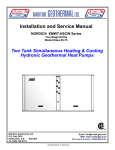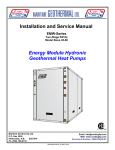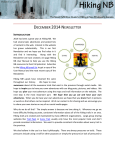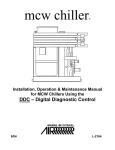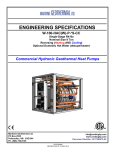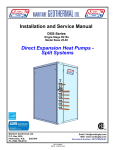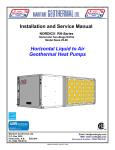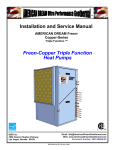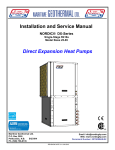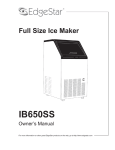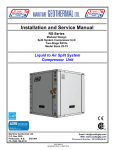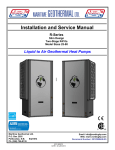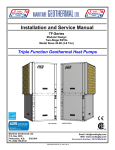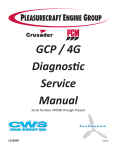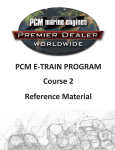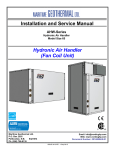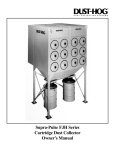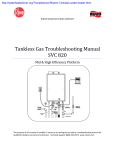Download EMWT HACW Manual - Nordic Geothermal Heat Pump
Transcript
Installation and Service Manual EMWT-HACW Series Two-Stage R410a Model Sizes 65-75 Two Tank Hydronic Geothermal Heat Pumps Maritime Geothermal Ltd. P.O. Box 2555 Petitcodiac, N.B. E4Z 6H4 Ph. (506) 756-8135 01 MAR 2012 Email: [email protected] Web: www.nordicghp.com Document Number: 000662MAN-03 REVISIONPage DATE:101 MAR 2012 000662MAN-03 ! ! SAFETY PRECAUTIONS WARNING: Ensure all access panels are in place and properly secured before applying power to the unit. Failure to do so may cause risk of electrical shock. WARNING: Before performing service or maintenance on the heat pump system, ensure all power sources are DISCONNECTED. Electrical shock can cause serious personal injury or death. WARNING: Heat pump systems contain refrigerant under high pressure and as such can be hazardous to work on. Only qualified service personnel should install, repair, or service the heat pump. CAUTION: Safety glasses and work gloves should be worn at all times whenever a heat pump is serviced. A fire extinguisher and proper ventilation should be present whenever brazing is performed. CAUTION: Venting refrigerant to atmosphere is illegal. A proper refrigerant recovery system must be employed whenever repairs require removal of refrigerant from the heat pump. MODEL NOMENCLATURE EMWT—65—HACW—P—1T—CC—12K—xx Revision: 01, 02 etc. Series: EMWT = Energy Module Liquid to water (Hydronic) with two tanks Electric Backup: 12K = 12 kW Nominal Size: 65 = 5 Ton 75 = 6 Ton Indoor Loop Exchanger: C = Copper Z = Cupro-Nickel (CuNi) Functions: H = Heating AC = Active Cooling W = Domestic Hot Water Outdoor Loop Exchanger: C = Copper Z = Cupro-Nickel (CuNi) Refrigerant: P = R410a Compressor Stages: T = 2 Stage Voltage Code: 1 = 230-1-60 VAC 2 = 208-3-60 VAC 6 = 220-1-50 VAC 7 = 380-3-50 VAC APPLICATION TABLE SIZE FUNCTION 65 75 HACW HACW REFRIGERANT P P VOLTAGE STAGES OUTDOOR COIL INDOOR COIL REVISIONS 1 T 2 T 6 T 7 T 06 1 T 06 2 S 6 T 7 T 06 C C C C 06 06 06 06 06 This manual applies only to the models and revisions listed in this table 000662MAN-03 Page 2 01 MAR 2012 Table of Contents INSTALLATION INFORMATION: ……………………...……….……………………………………………………………… Unit description: …………………………………………………………………………………………………..…... Unpacking the unit: …………………………………………………………………………………………………... Optimum Placement: …………………………………………………………………………………………………. Electrical Provisions: ………………………………………………………………………………………………… Circulator Pump Module Wiring (Ground Loop Only): …………………………………………………………. Control Requirements: ……………………………………………………………………………………………..... Safety Controls: ………………………………………………………………………………………………………. Indicator Lights: …………………………………………..………………………………………………………….. Loop Terminology: ……………….....……………………………………………………………………………….. Internal Hydronic Components: …..……………………………………………………………………………….. Electric Heat: …………………………….…………………………………………………………………………….. Heating Zone Connections: ……………...…….…………………………………………………………………… Cooling Zone Connections: ………………………………………………………………………………………… Purging the Indoor System: ………………………………………………………………………………………… Domestic Hot Water Connections: ………………………………...……………………………………………… PAGE 5 Page 5 Page 5 Page 5 Page 5 Page 5 Page 5 Page 6 Page 6 Page 7 Page 7 Page 7 Page 7 Page 7 Page 7 Page 8 THEORY OF OPERATION: ………….…………………………………….…………………………………………………… System Description: …………………………….…………………………………..………………………………. Compressor Operation: …………………………….………………………………………………………………. Heating Load Only Operation: …………………….………………………………………………………………. Cooling Load Only Operation: …………………….………………………………………………………………. Simultaneous Heating and Cooling Load Operation: …………………………………………………………. Priority Selection: ……………………………...…….………………………………………………………………. PAGE 11 Page 11 Page 11 Page 11 Page 11 Page 11 Page 11 SIZING AND HYDRONIC INFORMATION: ………….………………………………………………………………………… PAGE 12 Heat Pump Sizing: …………………………………….………………………………………………………………. Page 12 Hydronic Applications General: ………………...…………………………………………………………………. Page 12 GROUND WATER SYSTEM INFORMATION: ………………………………………………………………………………… PAGE 14 General Requirements: …………………….………………………………………………………………………… Page 14 Plumbing the Heat Pump: ……………………………………………………………………………………………. Page 14 Pipe Insulation: ………………………………………………………………………………………………………… Page 14 Water Discharge Methods: …………………………………………………………………………………………… Page 14 GROUND LOOP SYSTEM INFORMATION: ………………………………………………………………………………….. Circulator Pump Module: ……………………………………………………………………………………………. Flushing & Purging the Ground Loop: ……………………………………………………………………………. Adding Antifreeze Solution: ………………………………………………………………………………………… Initial Pressurization: ………………………………………………………………………………………………… Pipe Insulation: ……………………………………………………………………………………………………….. PAGE 17 Page 17 Page 17 Page 18 Page 18 Page 18 STARTUP PROCEDURE: ………………………………………………………………………………………………………. Pre-start Inspection: …………………………………………………………………………………………………. Unit Startup: …………..………………………………………………………………………………………………. Startup Record: ……………….………………………………………………………………………………………. Page 20 Page 20 Page 21 Page 22 GENERAL MAINTENANCE: ……………...…………………….……………………………………………………………… PAGE 23 TROUBLESHOOTING GUIDE: ………………………………….……………………………………………………………… PAGE 24 Repair Procedures: …………………………………………………………………………………………………… Page 33 Refrigeration Circuit Diagrams: ……………………………………………………………………………………. Page 34 MODEL SPECIFIC INFORMATION: ……………………..……………………………………………………………………. Refrigerant Charge Chart: …………………………………………………………………………………………… Shipping Information: ……………………………..………………………………………………………………… Standard Capacity Ratings: …………..……………………………………………………………………………. Capacity Ratings: ………..………………..…………………………………………………………………………. Electrical Tables: ……………………………………………………………………………………………………… Electrical Diagrams (230-1-60): ………..…………………………………………………………………………… Case Details: ………………………...………………………………………………………………………………… PAGE 36 Page 36 Page 36 Page 36 Page 38 Page 40 Page 41 Page 43 WARRANTY INFORMATION: ………………………………………………………………………………………………….. PAGE 44 01 MAR 2012 Page 3 000662MAN-03 Tables, Diagrams and Drawings TABLES Table 1 - Control Signal Description: …….………………………………………………………………..…….... Table 2 - Typical Aquastat Settings: ……………….……………………………………………………………... Table 3 - Control Board Fault Codes: ……..……………………………………………………….……………... Table 4 - Indicator Lights: …………………………………………………………………………………………… Table 5 - Compressor Truth Table (Heating Priority): …..………………………………….…………………... Table 6 - Compressor Truth Table (Cooling Priority): …..………………………………….…………………... Table 7 - Heat Pump Size vs. Heated Area for Ground Loop Systems: …..………………………………... Table 8 - Heat Pump Size vs. Heated Area for Ground Water Systems: ….………………………………... Table 9 - Required Flow and Air Bladder Tank Sizing: …..……………….…………………….……………... Table 10 - Antifreeze Percentages by Volume: ………………………………..………………………….……... Table 11 - Volume of Fluid per 100ft. Of Pipe: …..……………………..………….…………………….….…... Table 12 - Refrigerant –R410a: ……………………………...………………………………….…………………... Table 13 - Shipping Information: …..…………………………………….…………………….…………………... Page 5 Page 6 Page 6 Page 6 Page 11 Page 11 Page 12 Page 12 Page 14 Page 18 Page 18 Page 36 Page 36 Table 14 - Standard Capacity Ratings - Ground Loop Heating 60Hz: ………….………………………..…... Table 15 - Standard Capacity Ratings - Ground Water Heating 60Hz: ……………………………………... Table 16 - Standard Capacity Ratings - Ground Loop Cooling 60Hz: …...………………………….….…... Table 17 - Standard Capacity Ratings - Ground Water Cooling 60Hz: …..……....…….…………………... Table 18 - Heat Pump Electrical Information (230-1-60): …..…………………….……………………….…... Table 19 - Heat Pump Electrical Information (208-3-60): …..…………………….……………………….…... Table 20 - Heat Pump Electrical Information (220-1-50): …..…………………….……………………….…... Table 21 - Heat Pump Electrical Information (380-3-50): …..…………………….……………………….…... Page 36 Page 36 Page 37 Page 37 Page 40 Page 40 Page 40 Page 40 DIAGRAMS Diagram A - B&G NRF-36 Pump Curve: ………………..……………....…..………………….…………..…….. Diagram B - Circulator and Major Component Locations: ……………..………………….…………..…….. Diagram C - Typical P/T (Pete’s) Plug & Thermometer Stem: ……….…………………….…………..…….. Diagram D - Typical Purge Cart: …………………………………………………………………………………… Case Details: …………………………………………………………………………………………………………… Page 7 Page 8 Page 18 Page 18 Page 43 DRAWINGS 000665CDG - Typical Heating and Cooling Zone Wiring Diagram (EMWT-H*CW Series): …..….……….. 000970PDG - Single Unit Connection to DHW Pre-Heat Tank: ……………………………………………….. 000530PDG - Typical Zone Types for Hydronic Applications: …..……………..……………………………. 000907CDG - Typical Ground Water Installation for Size 25-75 Heat Pumps (Brass FPT): …………….. 000619INF - Ground Water Disposal Methods: ………………………………………………………………… 000906CDG - Geo-Flo Circulator Pump Module Installation (Brass FPT): ………………………………… 000421RCD - EMWT-HAC* - Series Refrigeration Circuit Diagram (Heating Mode): …….………………. 000422RCD - EMWT-HAC* - Series Refrigeration Circuit Diagram (Cooling Mode): …….………………. 000453SCH - EMWT-**-HSC*-**-1T-**-*** Schematic Diagram: ……………………………………………….. 000454SCH - EMWT-**-HSC*-**-1T-**-*** Schematic Diagram: ……………………………………………….. 000662MAN-03 Page 4 Page 9 Page 10 Page 13 Page 15 Page 16 Page 19 Page 34 Page 35 Page 41 Page 42 01 MAR 2012 Installation Information UNIT DESCRIPTION The EMWT-Series unit is a high efficiency R410a refrigerant two-stage geothermal heat pump with a hot and cold buffer tank, zone circulators, expansion tank, valves and gauges, and controls. It is a compact stand alone modular system that greatly reduces installation time and space. The unit has several key features that are described in the specifications document for the particular heat pump. Please request a copy if desired or visit www.nordicghp.com UNPACKING THE UNIT When the heat pump reaches its destination it should be unpacked to determine if any damage has occurred during shipment. Any visible damage should be noted on the carrier's freight bill and a suitable claim filed at once. CIRCULATOR PUMP MODULE WIRING (GROUND LOOP ONLY) The heat pump has provisions for connecting the circulator pump module so that the pumps will be turned on whenever the compressor operates. Connect the circulator pump module to the appropriate two terminals of the terminal strip marked OUTDOOR CIRCULATORS in the heat pump, as per the voltage of the circulator pump module. Ensure that the total current draw of all circulators connected to the terminal strip does not exceed the value indicated on the label in the heat pump electrical box. Refer to the electrical box drawing on the electrical box cover for more information. CONTROL REQUIREMENTS The heat pump is well constructed and every effort has been made to ensure that it will arrive intact, however it is in the customer's best interest to examine the unit thoroughly when it arrives. OPTIMUM PLACEMENT The placement of a hydronic unit has negligible effects on the operation of the system. For ground water systems, the unit can be placed near the well water system, ground loop system units can be place near where the header pipes enter the structure to keep the ground loop piping, heat pump and circulator pump module in one location. The hydronic layout may make a particular location ideal for the unit installation. The heat pump comes equipped with a two-stage heating aquastat and a two stage cooling aquastat. The stages are S1 = Stage 1 compressor, and S2 = Stage 2 compressor, as well as auxiliary heat on a 0-2 hour timer. The EMWT unit operation is self sufficient, the only control signals required are to turn on the Heating and Cooling Zone Circulator(s) located inside the unit The electrical box diagram on the electrical box cover provides a description of the signal connections in the heat pump. They are also listed in TABLE 1 below. The Heating Zone circulator is activated by connecting R and HZ together via dry contacts. The Cooling Zone circulator is activated by connecting R and CZ together via dry contacts. TABLE 1 - Control Signal Description Signal If possible the access panels should remain clear of obstruction for a distance of two feet to facilitate servicing and general maintenance. Raising the heat pump off the floor a few inches is generally a good practice since this will prevent rusting of the bottom panel of the unit. We recommend that the heat pump be placed on a piece of 2'' Styrofoam covered with 1/4'' plywood. The Styrofoam will smooth out any irregularities in the cement floor while the plywood will distribute the weight of the unit evenly over the Styrofoam. This process will also deaden the compressor noise emitted from the bottom of the cabinet. ELECTRICAL PROVISIONS The heat pump has a concentric 1.093” / 0.875” knockout for power supply connection to the electrical box. There are also two other 0.875” knockouts: one for connections to the indoor circulator; the other for connections to the circulator pump module for ground loop applications. There are three 1/2” openings with plastic grommets (grommet hole is 3/8”) in the upper section of the electrical box for connections to the controls. A schematic diagram and electrical box layout diagram can be found inside the electrical box cover for quick reference on the connections required. The electrical box diagram also contains information about the size of wire for the connections, as well as the recommended breaker size. A properly qualified electrician should be retained to make the connections to the heat pump and associated controls. The connections to the heat pump MUST conform to local codes. 01 MAR 2012 C R HZ CZ PR PR Description 24VAC Common (Ground) 24VAC Hot Heating Zone Circulator Cooling Zone Circulator Priority Select Priority Select Dry contacts are used for all heat pump connections to ensure that the heat pump control signals remain isolated from the rest of the system. The PR terminals are used to configure the priority of the unit. The unit is shipped with a jumper wire connected between the PR terminals to select cooling mode as the priority mode, remove the jumper to select heating as the priority mode. Drawing 000665CDG depicts a heating/ cooling wiring diagram. These drawings represent a basic system, in which heating is the default mode and cooling has priority. It is recommended that the system be designed by a qualified system designer to ensure proper functionality. TABLE 2 shows typical settings for the aquastats. With these settings, Stage 1 will activate when the tank temperature reaches the activation point. If the load is too great, the tank temperature will continue to drop when heating (rise when cooling) until Stage 2 is activated. As the tank temperature stops dropping and begins to increase when heating (decrease when cooling) , Stage 2 will turn off before Stage 1, rather than at the same time as Stage 1. There are three main advantages to this: • Less aquastat probe lag leading to reduced overshoot as the Page 5 000662MAN-03 tank temperature rate of change is reduced when only Stage 1 is active. • • 1. Low or no Hot Indoor loop flow. 2. High Hot Indoor loop entering liquid temperature. 3. Dirty or fouled Hot Indoor loop heat exchanger. Prolonged Stage 1 runtime leads to increased overall efficiency as Stage 1 has a higher COP than Stage 2. Reduced number of compressor starts. The settings may be changed as desired; however Stage 1 setpoint for heating should not exceed 120°F (49°C); Stage 1 cooling setpoint should not be set below 43°F (6°C). Exceeding these setpoint limits will cause the heat pump operating pressures to approach the safety control settings, possibly causing nuisance shut downs. TABLE 2 - Typical Aquastat Settings HEATING AQUASTAT Stage 1 Item Setpoint Stage 2 °F °C °F °C 105 41 100 38 Delta 8 4 8 4 Activation * 97 37 92 34 COOLING AQUASTAT Stage 1 Item °F Stage 2 °C °F °C Setpoint 45 7 50 10 Delta 8 4 8 4 Activation * 53 11 58 14 *Activation is indirectly set by the Setpoint and Delta values The unit contains a control board that monitors the safety controls and operates the compressor accordingly. The low pressure control is connected to LP1 and LP2. The high pressure control is connected to HP1 and HP2. The control board also has provisions for a flow switch. The flow switch is unused from the factory and a jumper wire is placed across the FLOW SWITCH terminals. If a flow switch is desired, the jumper can be removed and the two leads from the flow switch can be connected to the FLOW SWITCH terminals on the safety board. The flow switch is ignored for 30 seconds on compressor startup to allow time for flow to be established. The high and low pressure controls are monitored at all times, the compressor will not be able to start if either of them has a fault. The control board has an on-board LED and a FAULT pin with a 24VAC output. An external indicator or relay can be connected across the FAULT pin and ground if external signaling is desired. Should a fault occur, the LED will flash the code of the fault condition while the safety control in question is open The codes are shown in TABLE 3. The control board will lock out the compressor for five minutes when a fault occurs. Three retries per fault condition are allowed within a 60 minute period. If the fault condition occurs a fourth time the control board will permanently lock out the compressor and energize the FAULT pin. This can only be reset by powering down the unit. The LED will flash the fault code until the unit is reset. If the control board enters permanent lockout mode there is a serious problem with the system and it must be rectified if the unit is to maintain good service. If fan coils are being heated, it may be required to increase the heating setpoints by 10°F (6°C) in order to obtain the required heating capacity. TABLE 3 - Control Board Fault Codes Fault SAFETY CONTROLS The heat pump has two built in safety controls which are designed to protect the unit from situations which could damage it should the operation of the refrigeration circuit fall outside the allowable operating range. A. Low Pressure Control The low pressure control monitors the compressor suction pressure and will shut the compressor down if the refrigerant evaporating pressure becomes too low, risking the danger of freezing conditions in the evaporator. There are (3) main reasons why this control would activate in response to the operating conditions of the unit while operating in heating mode: Code High Pressure 1 Low Pressure Flow 2 3 ! WARINING: If the the heat pump is permanently locking out on the LOW pressure control, repeated resetting of the unit could cause the heat exchanger to freeze and rupture destroying the heat pump and voiding the warranty. INDICATOR LIGHTS The EMWT-Series unit has three indicator lights on the side of the electrical box. They are described in TABLE 4. TABLE 4 - Indicator Lights 1. Low or no Outdoor loop flow. 2. Low Outdoor loop entering liquid temperature. 3. Dirty or fouled Outdoor loop heat exchanger. Colour B. High Pressure Control The high pressure safety control monitors the compressor discharge pressure and will shut the compressor down if the condensing pressure becomes too high. Indicates Green Compressor ON Yellow Red Electric Elements ON Trouble (Locked out) There are (3) main reasons why this control would activate in response to the operating conditions of the unit while operating in heating mode: 000662MAN-03 Page 6 01 MAR 2012 LOOP TERMINOLOGY ELECTRIC HEAT The following terms are used to describe the various “loops” of the EMWT heat pump system: • • • • • • The Hot Tank contains electric elements for the purpose of auxiliary / backup heat. The control for the electric heat comes from the Heating Aquastat Stage 2 signal. The signal passes through a 0– 2H timer before reaching the electric heat contactor coil. The timer is set to 1H ( one hour) at the factory. Outdoor Loop— Connections for the ground loop exchanger or ground water system. Hot Zone Loop—Connections for building heating zone loop. The Hot Zone Circulator provides flow for this loop. The unit is shipped with the electric heat breaker in the off position. IT IS VERY IMPORTANT THAT THE INDOOR LOOP IS FLOODED AND PRESSURIZED BEFORE TURNING ON THE ELECTRIC HEAT BREAKER. An electric element that is not under water will burn out in a matter of seconds. There is a safety pressure switch mounted to the side of the Hot Tank, the electric heat contactor will not engage unless the pressure in the indoor loop is above 10PSIG. Should the heat pump require service, the compressor breaker should be turned off. This prevents the refrigeration section from operating but allows the electric heat to continue operating until the unit can be repaired. Cold Zone Loop—Connections for building cooling zone loop. The Cold Zone Circulator provides flow for this loop. Hot Indoor Loop—Hot water loop between the condenser and the Hot buffer tank (inside the unit). Cold Indoor Loop—Cold water loop between the evaporator and the Cold buffer tank (inside the unit). HEATING ZONE CONNECTIONS DHW Loop—Connections for the Domestic Hot Water. INTERNAL HYDRONIC COMPONENTS The EMWT-Series unit has virtually everything required for a hydronic installation built into it, including the following: • • • • • • • • • 50 USGAL (189L) Hot buffer tank with electric backup 50 USGAL (189L) Cold buffer tank The Heating Zone ports are 1” FPT brass fittings (refer to CASE DETAILS). The heating zone header pipes can be connected to these ports. The Heating Zone Circulator is activated by connecting R and HZ together via dry contacts. COOLING ZONE CONNECTIONS The Cooling Zone ports are 1” FPT brass fittings (refer to CASE DETAILS ). The cooling zone header pipes can be connected to these ports. The Cooling Zone Circulator is activated by connecting R and CZ together via dry contacts. Pre-charged expansion tank PURGING THE INDOOR SYSTEM 75PSIG pressure relief valve There are ball valves and boiler drains inside the unit to facilitate filling and purging. Refer to DIAGRAM B and drawing 000421RCD for component locations. Once the system has been filled with the desired fluid, purging may be done in the following manner: Hot Zone Circulator (B&G NRF-36) with isolation valves Cold Zone Circulator (B&G NRF-36) with isolation valves Pressure gauges Shutoff valves and boiler drains for purging Individual heating and cooling tank aquastats Refer to Diagram B for the locations of the components. The pump curve for the Heating and Cooling zone circulators is shown in Diagram A. DIAGRAM A - B&G NRF-36 Pump Curve 1. 2. 3. 4. 5. 6. 7. 8. 9. 10. 11. 12. 13. 14. 15. 16. 17. 18. 19. 20. 21. 22. 23. 24. 01 MAR 2012 Page 7 Connect a fill hose to the Hot Zone Boiler Drain. Connect a drain hose to the Hot Indoor Boiler Drain. Close the top isolation valve of the Hot Zone Circulator. Close the top isolation valve of the Hot Indoor Circulator. Open the Hot Zone and Hot Indoor Boiler Drains. Open the fill hose valve. Purge until no air can be heard leaving the drain hose. Close the Hot Zone Ball Valve and the Hot Indoor Ball Valve. Open the top isolation valve of the Hot Zone and Hot Indoor Circulators. Close the Cold Indoor Ball Valve. Purge until no air can be heard leaving the drain hose. Close the Hot Zone and Hot Indoor Boiler Drains. Move the drain hose to the Cold Indoor Boiler Drain. Open the Cold Indoor Boiler Drain. Close the top isolation valve of the Cold Indoor Circulator. Open the Cold Indoor Ball Valve. Open the Hot Zone Boiler Drain. Purge until no air can be heard leaving the system. Close the Cold Indoor Ball Valve. Close the fill hose valve. Close the Hot Zone Boiler Drain and the Cold Indoor Boiler Drain. Move the fill hose to the Cold Zone Boiler Drain. Close the top isolation valve of the Cold Zone Circulator. Open the Cold Zone and Cold Indoor Boiler Drains. 000662MAN-03 25. 26. 27. 28. 29. 30. 31. 32. 33. 34. 35. 36. 37. 38. 39. 40. Open the fill hose valve. Purge until no air can be heard leaving the system. Close the Cold Zone Ball Valve Open the top isolation valve of the Cold Zone Circulator. Purge until no air can be heard leaving the system. Close the Cold Indoor Boiler Drain. Move the drain hose to the Hot Indoor Boiler Drain. Open the top isolation valve of the Cold Indoor Circulator. Open the Hot Indoor Boiler Drain. Purge until no air can be heard leaving the system. Close the Hot Indoor Boiler Drain. Close the Cold Zone Boiler Drain when the system reaches the desired pressure level. Close the fill hose valve and disconnect the hoses. Open the Cold Zone and Cold Indoor Ball Valves. Open the Hot Zone and Hot Indoor Ball Valves. Do a final check of all ball valves and isolation valves to ensure they are all open. Repeat the above procedure as necessary to ensure that all of the air has been removed, then remove the purging equipment. DOMESTIC HOT WATER CONNECTIONS ! CAUTION: the domestic hot water pump is water lubricated; damage will occur to the pump if it is run dry for even a short period of time. The DHW loop may have to be purged of air several times before good circulation is obtained. A temperature difference between the DHW In and DHW Out can be felt by hand when the circulator pump is operating properly. The final tank should be set to 140°F(60°C). The pre-heat tank does not require electric elements. This setup takes full advantage of the desuperheater as it is the sole heat provider to the pre-heat tank. The desuperheater remains active during the compressor runtime until the pre-heat tank has been completely heated by the desuperheater alone. This setup is more energy efficient than a single tank setup. CAUTION: If two (2) shut-off valves are located on the domestic hot water ines as shown in the diagram, a pressure relief valve must be installed to prevent possible damage to the domestic hot water circulator pump should both valves be closed. A typical piping diagram for a two tank (pre-heat tank) configurations can be found in drawing 000970PDG at the end of this section. Be sure to note the position of the check valve and the direction of water flow. Other configurations are possible, and there may be multiple units tied together in larger buildings. ! CAUTION: Use only copper pipe to connect the desuperheater. Should the DHW thermostat fail, the water temperature could rise to as high as 200°F (93°C). Ensure the tank is filled with water and under pressure before activating the heat pump. Slightly loosen the boiler drain on the DHW Out pipe to allow air to escape from the system before the unit is started. This step will make certain that the domestic hot water circulator in the unit is flooded with water when it is started. DIAGRAM B - Circulator and Major Component Locations DHW Circulator Cold Indoor Circulator (Evaporator) Expansion Tank Hot Indoor Circulator (Condenser) Safety Pressure Switch for Electric Backup Cold Tank Hot Tank Probe Cold Zone Circulator Hot Tank Evaporator Hot Zone Circulator Cold Tank Probe Condenser TXV Filter-drier 000662MAN-03 Page 8 01 MAR 2012 01 MAR 2012 Page 9 000662MAN-03 000662MAN-03 Page 10 01 MAR 2012 Theory of Operation TABLE 5 - Compressor Truth Table (Heating Priority) SYSTEM DESCRIPTION The EMWT-HACW heat pump is a stand alone reversing system which contains both a hot and cold buffer tank. The unit will maintain each of the tanks at the desired setpoint by automatically switching modes between heating and cooling. Heating The compressor operates based on the combination of the calls for heating and cooling loads. The operation is as shown in TABLE 5 for when the unit is set to heating priority and TABLE 6 for when the unit is set for cooling priority. Impossible combinations have been removed from the table for simplicity. There are three different operating scenarios for this unit: heating load only, cooling load only, and simultaneous heating and cooling loads. Each of these scenarios is explained in the following sections. 0 0 0 0 0 0 0 0 1 1 1 1 1 1 0 0 0 0 0 1 1 1 1 1 0 1 1 0 1 1 0 1 0 0 1 0 0 1 1 1 1 1 1 1 1 1 0 1 0 0 1 1 1 1 C C H H H H H H TABLE 6 - Compressor Truth Table (Cooling Priority) Heating If the heating load is large enough, the Hot Tank will continue to drop in temperature. When the heating Stage 2 activation temperature is reached, the compressor solenoid will be energized to operate the compressor in full load mode. In the cooling load only scenario, the Cold Tank will see a temperature rise the due to the cooling load. When the Cold Tank reaches the Stage 1activation temperature the compressor will start (part load mode), the Hot Indoor and Cold Indoor circulators will be turned on to circulate fluid between the heat exchangers. If the cooling load is still too large, the Cold Tank will once again continue to rise in temperature. When the cooling Stage 2 activation temperature is reached, the compressor solenoid will be energized to operate the compressor in full load mode. 01 MAR 2012 Compressor Mode 0 0 0 0 0 0 0 0 0 1 1 1 1 1 1 0 0 0 0 0 1 1 1 1 1 0 1 1 0 1 1 0 1 0 0 1 0 0 1 1 1 1 1 1 1 1 1 0 1 0 0 1 1 1 1 C C H C C H C C SIMULTANEOUS HEATING AND COOLING LOAD OPERATION If the heating load is still too large, the Hot Tank will once again continue to drop in temperature. When the heating Stage 3 activation temperature is reached, the electric elements will be brought on. As described previously, this unit has two cooling stages: Stage 1 = Stage 1 compressor (part load), and Stage 2 = Stage 2 compressor (full load). Cooling Stage 1 Stage 2 Stage 1 Stage 2 Stage 1 Stage 2 In the heating load only scenario the Hot Tank will see a temperature drop due to the heating load. When the Hot Tank reaches the heating Stage 1 activation temperature, the compressor will start (part load mode) and the Hot Indoor circulator will be turned on to circulate fluid between the heat exchanger and the tank. COOLING LOAD ONLY OPERATION Mode 0 HEATING LOAD ONLY OPERATION As the heating load becomes satisfied, the Hot Tank will begin to rise in temperature. Each heating stage will shut off at its setpoint value and the Hot Tank will be satisfied. Compressor Stage 1 Stage 2 Stage 1 Stage 2 Stage 1 Stage 2 COMPRESSOR OPERATION As described previously, this unit has three heating stages: Stage 1 = Stage 1 compressor (part load), Stage 2 = Stage 2 compressor (full load), and Stage 3 = heating tank electric elements. Cooling When there are both heating and cooling loads present, the heat pump will operate in the mode that has been set as prioriy until the priority tank has been satisfied. It will then switch to the default mode in order to satisfy the default tank. In addition, if there is a Stage 1 call on one mode and a Stage 2 call of the other mode occurs, the compressor will automatically be set to Stage 2 to complete the cycle as fast as possible in order to switch to the other mode and satisfy the demand. PRIORITY SELECTION To set the cooling mode as priority, connect a jumper wire between the two PR terminals in the electrical box (refer to the SCH and ELB diagrams). To set the heating mode as priority, disconnect the jumper between the two PR terminals in the electrical box. Units are shipped with a jumper wire between the PR terminals. Page 11 000662MAN-03 Sizing and Hydronic Information HYDRONIC SYSTEMS - GENERAL HEAT PUMP SIZING TABLE 7 depicts a rough guideline as to the size of home each heat pump size can handle for ground loop installations. Hydronic systems typically provide heat through two different types of media: • • TABLE 7 - Heat Pump Size vs. Heated Area for a Ground Loop System Model Size (tons) Sq.ft. Sq.m. 65 75 5 6 2,600 3,100 240 290 TABLE 8 depicts a rough guideline as to the size of home each heat pump size can handle for ground water installations. TABLE 8 - Heat Pump Size vs. Heated Area for a Ground Water System Model Size (tons) Sq.ft. Sq.m. 65 75 5 6 3,200 3,800 295 355 radiant in-floor heating forced air heating via fan coil units One of the benefits of hydronic systems is the flexibility in setting up the heating system. Whereas a typical forced air system has one central thermostat controlling the entire heating system, the home may be sectioned into several areas called zones with a hydronic system. Each zone has its own thermostat, allowing simple separate temperature control of the individual areas in the home. There are other uses for hydronic systems, the two most common being on-demand domestic hot water and pool/spa heating. Drawing 000530PDG shows the most common types of zones. A typical system consists of the heat pump, the buffer tank and the zones. For the EMW-Series, the buffer tank is part of the heat pump unit. The heat pump’s sole purpose is to maintain the buffer tank set point. Its operation is independent of the zone operation. THE TABLES ABOVE ARE FOR INFORMATION ONLY, THEY SHOULD NOT BE USED TO SELECT A UNIT SIZE. They simply show on average what size unit is required for a typical two-level home (main level and below grade basement) with R-20 walls, R-40 ceiling and average size and number of windows. The Heated Area is the area of the main level, The tables account for a basement the same size as the heated area. Fan coils can be used to provide heating and/or cooling for areas that do not have radiant in-floor heating. They provide a means of air heating /cooling with minimal or no ductwork. Note that the buffer tank temperature should be set for 115°F (46°C) if there are fan coils in the system. MARITME GEOTHERMAL LTD. HIGHLY RECOMMENDS THAT A PROPER HEAT LOSS/GAIN ANALYSIS BE PERFORMEDE BY A PROFESSIONAL INSTALLER WITH CSA APPROVED SOFTWARE BEFORE SELECTING THE SIZE OF UNIT REQUIRED FOR THE APPLICATION. For heating dominant areas, we recommend sizing the unit to 100% of the heating design load for maximum long term efficiency with minimal supplementary heat. The unit should be installed as per CSA 448.2-02. For ground loop applications, the ground exchanger should be designed using suitable software with a multi-year analysis. Four port fan coils are recommended for connection to the system to keep separate piping for heating and cooling zones as there are individual hot and cold tanks in the unit. It is recommended that all piping be insulated with 3/8” thick closed cell pipe insulation. This is a MUST for any piping that is used for cooling to prevent dripping onto floors and walls. Care should be taking when wiring the system to ensure that radiant in-floor heating zones are disabled whenever the heat pump is switched to cooling mode. There are many factors to consider when sizing the heat pump. Some of these factors include the number of levels, the size of the windows, the orientation of the home, attached garage, bonus rooms, walk-in basement, coldest outdoor temperature, etc. The heat loss program will take all of these factors into consideration in its calculations. An undersized installation will require not be as efficient and will required expensive auxiliary heat to maintain a comfortable temperature in the home, and the cost savings of having a geothermal heat pump are greatly reduced. Once the total heat loss has been calculated, the unit can be sized using the performance tables (from the specifications document) in conjunction with the minimum expected entering liquid temperature of the ground loop (well water temperature for ground water system). The heat pump output must be able to match the total heat loss at the selected entering water temperature in order to provide a comfortable environment with minimal auxiliary heat. 000662MAN-03 Page 12 01 MAR 2012 01 MAR 2012 Page 13 000662MAN-03 Ground Water System Information GENERAL REQUIREMENTS 1. Another more common method of regulating the flow is by the use of a DOLE Valve. This valve will automatically control the amount of water flowing through it by varying the diameter of a flexible rubber orifice through which the water passes. This minimizes the water usage of the unit and also prevents a reversing unit from running excessively low discharge pressure when in cooling mode. Dole valves can be noisy, it is recommended that they be installed outside if possible. The temperature of the well water should be a minimum of 39°F (4°C), and should normally be 45+°F (7°C) The well system must be able to supply the required water flow as listed under the Total Flow column in TABLE 9. 2. TABLE 9 - Required Flow and Air Tank Sizing Heat Pump Model Size Heat Pump Flow* IGPM (USGPM) Home Flow IGPM (USGPM) Total Flow IGPM (USGPM) Minimum Air Bladder Tank** IGal (USgal) 65 12 (14.4) 3 (3.6) 15(18.0) 30(36) 75 14 (16.8) 3 (3.6) 17(20.4) 34(41) Optionally a water flow meter can be installed in the discharge line so that the exact amount of water flowing can be determined at a glance. It should be placed between the Outdoor OUT (Supply OUT) pipe of the heat pump and the water valve. With proper flow, there should be 5-7°F (3-4°C) delta T between the IN and OUT water temperatures of the heat pump when operating in the heating mode. All water line valves on both the supply and discharge lines should be either BALL or GATE valves. GLOBE valves have a higher pressure drop, meaning more pumping power to maintain the required flow to the heat pump. * These are minimum water requirements based on an entering water temperature of 46° F. **Based on two-minute well pump run time. Use next size larger tank if there is not a match for the value indicated. PIPE INSULATION PLUMBING THE HEAT PUMP Plumbing lines, both supply and discharge, must be of adequate size to handle the water flow necessary for the heat pump. A 1” copper or plastic line should be run to the Outdoor IN (Supply IN) pipe of the heat pump. Similarly, a 1”' line should be run from the Outdoor OUT (Supply Out) pipe to the method of disposal. P/T plugs should be installed at each port. See Diagram A in the Ground Loop section for a description of P/T plugs. The water valve should be installed in the discharge line. Refer to drawing 000907CDG at the end of this section for the recommended setup. Placing the water valve in the discharge line ensures that the heat exchanger inside the heat pump remains full of water when the unit is not running. Unions or some other form of disconnect should be used so that the coaxial heat exchanger may be accessed should it required cleaning. The heat pump has an electrical connector for the water valve just inside the case. After the water valve is installed, run the valve harness into the case through the hole provided. Remove the jumper plug from the Valve Connector and connect the harness in its place. All ground water piping to and from the Outdoor Loop ports on the heat pump should be insulated with 3/8” closed cell pipe insulation, to prevent condensation and dripping onto floors or walls. WATER DISCHARGE METHODS Water disposal methods vary from area to area. However, some consideration should be made to prevent the cooled discharge water from immediately coming in contact with the supply source. Attempting to return the water to the source well will eventually cool the water so much that the heat pump will shut off on its low pressure safety control. Acceptable methods for disposing of the waste water are listed below. The waste water is clean, the heat pump has no other effect than reducing the temperature of the water. Refer to the Ground Water Disposal methods diagram for typical disposal method diagrams. Second well (return well) Percolation (Drain, ditch, leaching field) Pond, river or stream. Ideally there will be water flow available in excess of the requirement of the heat pump. In such a situation the proper pump can be selected to maintain a pressure of 30 to 40 psig. on the lines when the heat pump is operating. However in some cases a well can supply a heat pump only if the minimum requirement for water is used. ENSURE SELECTED WATER DISCHARGE METHOD CONFORMS TO LOCAL CODES. Water flow to the heat pump can be controlled very accurately by the installation of a reverse action refrigeration pressure valve in the discharge line of the unit. 000662MAN-03 Page 14 01 MAR 2012 A return well should be a minimum of 80 ft. from the supply well for residential applications. The water returned to the well will not necessarily be pumped into the same aquifer, depending on underground conditions. The return must be able to supply at least the same quantity of water as the amount you wish to recharge into it. If the static level (level when not being pumped) of a well is high (10 to 20 ft. from the surface) it may be necessary to place a well cap on the well to keep the return water from flowing out the top of the well. This cap is commonly required since a certain amount of pressure is needed to force the return water back down the well if the static level is high. Water discharged by percolation will generally soak into the ground within a distance of 50 to 100 ft. If suitable care is taken to ensure that the drain pipe runs downhill and the end of the pipe is protected by a bale of hay or spruce bows etc. the end of the pipe will not freeze as the pipe will empty out when the heat pump shuts off and the water valve closes. 01 MAR 2012 When snow comes it will usually cover the entire process much like a small spring. It is recommended that the pipe be below the frost line when possible for maximum freeze protection. When discharging into a river or stream, or above the surface of a pond, the same guidelines should be followed as described in the paragraph above for the percolation method. When discharging the waste water below the surface of a pond, the discharge pipe should be placed below the frost line to prevent the pipe from freezing. As opposed to the percolation method, water will remain in the end of the pipe. It is recommended that the surface of the pond be lower than the installation location of the heat pump where practical. This reduces the back pressure generated by the weight of the water in the pond. Page 15 000662MAN-03 000662MAN-03 Page 16 01 MAR 2012 Ground Loop System Information Once the ground loop has been pressure tested and the header pipes have been connected to the circulator pump module, the heat pump can be connected to the circulator pump module. CIRCULATOR PUMP MODULE Maritime Geothermal Ltd. has compact pump modules with built in three way valves to facilitate filling and purging the ground loop. Refer to drawing 000906CDG at the end of this section. Alternatively, Grundfoss® Model UPS 26-99 or Taco® Model 0011 pumps or other brands with similar pumping capability may be used. The single pump module will typically handle systems up to 3 tons (model sizes 25, 35, and 45); the two pump module will typically handle 4 to 6 ton systems (model sizes 55, 65, 75). This is based on a typical parallel system with one circuit per ton. Maritime Geothermal recommends calculating the total pressure drop of the ground loop (including headers, indoor piping and heat pump exchanger drop) based on the antifreeze type and concentration at the desired minimum loop temperature. A pump module that can deliver the flow required for the unit at the calculated total pressure drop should be selected. Refer to the Model Specific Information section for unit flow requirements. The P/T plug will allow the installer or homeowner to check water flow through the loop by measuring the pressure difference through the heat exchanger and comparing it to that listed in the Model Specific Information section, or the specifications document. Optional fittings with P/T ports are available for the circulator pump modules sold by Maritime Geothermal Ltd.. FLUSHING & PURGING THE GROUND LOOP Once the groundloop has been installed and all connections are completed between the heat pump, circulator pump module and ground loop, the entire ground loop system should be pressure tested with air to 100 PSIG to make sure there are no leaks on any of the inside fittings. Soap all joints and observe that the pressure remains constant for 1 hour. When satisfied that all connections are leak free, release the air pressure and connect a purge cart (see Diagram D ) to the flushing access ports at the pump module (refer to drawing 000906CDG). A temporary flushing system can alternately be constructed using a 45 gal. barrel and a pump with sufficient volume and head capability to circulate fluid at a velocity of at least 2 ft./min. through all parts of the loop. DIAGRAM D - Typical Purge Cart Loop pressure drops can be calculated using software such as those mentioned in the Horizontal Ground loops section, or can be calculated in a spreadsheet using the pipe manufacturer’s pressure drop tables for pipe diameter and fittings. The circulator pump module must be connected to the heat pump Outdoor Loop ports with a lineset suitable for the flow required with minimum pressure drop. 1” rubber or plastic lines should be used. The installation of P/T plugs (pressure / temperature, pronounced “Pete’s plugs” ) is recommended on both the entering and leaving lines at the heat pump (see Diagram C). DIAGRAM C - Typical P/T – “Pete’s” Plug & Thermometer Stems Adjust the circulator pump module valves to connect the purge cart to the ground loop. Begin pumping water through the ground loop, ensuring that the intake of the pump stays submerged at all times by continuously adding water. Water flowing back from the return line should be directed below the water level in the barrel or flush tank to prevent air being mixed with the outgoing water. 01 MAR 2012 Page 17 000662MAN-03 Once the lines have been filled and no more air bubbles are appearing in the line, adjust the circulator pump module valves to circulate water through the heat pump using the same technique as described above. When all air is removed reverse the flow of water through the lines by interchanging the flush cart lines and purge again. You will be able to visibly tell when all air is removed. TABLE 11 - Volume of fluid per 100 ft. of pipe Volume /100ft. Type of Pipe Diameter Igal USgal L Copper 1” 3.4 4.1 15.5 1-1/4” 5.3 6.4 24.2 1-1/2” 7.7 9.2 34.8 Rubber Hose 1” 3.2 3.9 14.8 Polyethylene 3/4” IPS SDR11 2.3 2.8 10.6 1” IPS SDR11 3.7 4.5 17.0 1-1/4” IPS SDR11 6.7 8.0 30.3 1-1/2” IPS SDR11 9.1 10.9 41.3 2” IPS SDR11 15.0 18.0 68.1 Average 1.2 1.5 5.7 15”D x 3 ft. high 23.3 28 106 ADDING ANTIFREEZE SOLUTION In most mid and northern areas of the US and in all of Canada it is necessary to condition the loop fluid by the addition of some type of antifreeze solution so that it will not freeze during operation in the winter months. This antifreeze is required because the loop fluid will normally reach a low entering temperature of 28°F to 32°F (-2°C to 0°C) and refrigerant temperatures inside the heat pump’s heat exchanger may be as low as 20°F (11°C) cooler. See TABLE 10 for details of freeze protection provided by different concentrations. TABLE 10 - Antifreeze Percentages by Volume Protection to: 10°F 15°F 20°F 25°F Heat Exchanger Methanol 25% 21% 16% 10% Flush Cart Tank Propylene Glycol 38% 30% 22% 15% NOTE: Add enough antifreeze to allow for a temperature 20°F lower than the expected lowest loop fluid temperature entering the heat pump. Although many different antifreeze solutions have been employed in geothermal systems, the alcohols such as methanol or ethanol have the most desirable characteristics for groundloop applications. The overall heat transfer characteristics of these fluids remain high although care must be taken when handling pure alcohols since they are extremely flammable. Once mixed in a typical 25% by volume ratio with water the solution is not flammable. In situations where alcohols are not allowed as a loop fluid due to local regulations then propylene glycol is a non-toxic alternative which can be substituted . Propylene glycol should only be used in cases where alcohols are not permitted since the heat transfer characteristics are less desirable and it becomes more viscous at low temperatures, increasing pumping power. The volume of fluid that your loop system holds can be closely estimated by totaling the number of ft. of each size pipe in the system and referencing TABLE 11 the for approximate volume per 100 ft. When the volume of the loop has been calculated and the appropriate amount of antifreeze is ready for addition by referencing TABLE 10 , drain the equivalent amount of water from the flush cart or mixing barrel and replace it with the antifreeze. • Pressurize the loop to a static pressure of 45 psig. when installing a system in the fall going into the heating season. • Pressurize the loop to a static pressure of 25 psig. when installing a system in the spring or summer going into the cooling season. After operating the heat pump for a period of time, any residual air in the system should be bled off and the static pressure should be verified and adjusted if necessary. Add additional water / antifreeze mix with the purge cart to bring the pressure back to the original setting if required. PIPE INSULATION When using alcohols, be sure to inject below the water line to reduce initial volatility of the pure antifreeze. If the loop is large it may be necessary to refill the tank with antifreeze several times to get all the antifreeze into the loop. Pump the loop for 5 to 10 minutes longer to ensure the remaining fluid has been well mixed. 000662MAN-03 INITIAL PRESSURIZATION At this point open all valves in the flow circuit and slowly close off the supply and return flush cart valves in a manner that leaves about 20-30 psig. on the system. If an air bladder expansion tank is used it should be charged to the above pressure before actual water pressure is put on the system . Systems without an expansion tank will experience greater fluctuations in pressure between the heating and cooling seasons, causing pressure gauges to have different values as the loop temperature changes. This fluctuation is normal since expansion and contraction of the loop fluid must be handled by the elasticity of the plastic loop. All ground loop piping inside the structure (between the structure entry point and the heat pump) should be insulated with 3/8” thick closed cell pipe insulation to prevent condensation and dripping onto floors or walls. Page 18 01 MAR 2012 01 MAR 2012 Page 19 000662MAN-03 Startup Procedure The following steps describe how to perform the startup procedure of the geothermal heat pump. The EMWT-HACW Series Two-Stage R410a Startup Record located in this manual is used in conjunction with this startup procedure to provide a detailed record of the installation. A completed copy should be left on site, a copy kept on file by the installer and a copy should be sent to Maritime Geothermal Ltd. Check the boxes or fill in the data as each step is completed. For data boxes, circle the appropriate units. Fill in the top section of all three copies, or one copy if photocopies can be made after the startup has been completed. PRE-START INSPECTION Heating and Cooling Zone Loops: 1. Verify that all shutoff valves inside the unit are fully open. 2. Verify that the entire system has been flooded and all the air has been purged as much as possible. Further purging may be required after the system has been operating for a while. 3. Verify that the loop contains the proper mix of antifreeze (if used) for the intended application. If applicable, record the type of antifreeze and the mixture value on the startup sheet, circle % Vol. or % Weight. 4. Record the static loop pressure on the startup sheet. The value must be above 12PSIG. The electric heat will not function if the pressure is below this value. Outdoor Loop (Ground Loop): 1. Verify that all shutoff valves are fully open and there are no restrictions in the piping from the heat pump to the ground loop, and that full flow is available to the heat pump. 2. Verify that the entire system has been flooded and all the air has been purged as much as possible. Further purging may be required after the system has been operating for a while. 3. Verify that the loop contains the proper mix of antifreeze for the intended application. Record the type of antifreeze and the mixture value on the startup sheet; circle % Vol. or % Weight. 4. Record the static loop pressure on the startup sheet. Outdoor Loop (Ground Water): 1. Verify there are no leaks in the connections to the unit. Verify the water valve is installed and properly oriented in the return line. 2. Verify that there is flow control in the return line. Domestic Hot Water (if equipped): 1. Verify that all shutoff valves are fully open and there are no restrictions in the piping from the heat pump to the domestic hot water tank. 2. Verify that the entire system has been flooded and all the air has been purged as much as possible. Further purging may be required after the system has been operating for a while. 3. Verify that the brown wire with the insulated terminal is disconnected in the electrical box. Refer to the schematic diagram for more information. Electrical: 1. Ensure the power to the unit is off. 2. Verify all high voltage connections. Ensure that there are no stray wire strands, all connections are tight and the ground wire is connected tightly to the ground connector. 3. Record the fuse / circuit breaker size and wire gauge for the heat pump. 4. Verify that the control connections to the are properly connected and all control signals are off. 5. Turn both breakers off in the unit electrical box , so that the unit will not start when the power is turned on. 6. Verify that the circulator pumps are connected to the proper voltage terminals in the heat pump. Record the voltages of the circulator pumps. 7. Ensure all access panels except the one that provides access to the electrical box are in place. 000662MAN-03 Page 20 01 MAR 2012 UNIT STARTUP The unit is now ready to be started. The steps below outline the procedure for starting the unit and verifying proper operation of the unit. It is recommended that safety glasses be worn during the following procedures. Preparation: 1. Remove the caps from the service ports and connect a refrigeration manifold set to the unit. 2. Turn the power on to the heat pump and set all controls (including all zone thermostats) to OFF. 3. Measure the following voltages on the power block and record them on the startup sheet: L1-L2, L2-L3, L1-L3. 4. Verify that the green light on the side of the cabinet is on. Heating Mode: 1. Turn the compressor breaker on. The compressor will start (allow 30-60 seconds for the water valve to open for ground water systems) as well as the circulator pumps. 2. Check the refrigeration gauges. The suction and discharge pressures will depend on the loop temperatures, but they should be about 90-110PSIG and 250-320PSIG respectively for a typical start-up. 3. Monitoring the refrigeration gauges while the unit runs. Record the following after 10 minutes of runtime: 1. Suction pressure 2. Discharge pressure 3. Outdoor Loop In (Supply In) temperature 4. Outdoor Loop Out (Supply Out) temperature 5. Outdoor Delta T (should be between 5-8°F, 3-4°C) 6. Outdoor flow (if available) 7. Compressor L1(C) current (black wire, place meter between electrical box and compressor) 4. Let the unit run through a cycle. Record the setpoint and the discharge pressure when the unit shuts off. 5. For units with a desuperheater, turn the power off to the unit. Connect the brown wire with the blue insulated terminal to the compressor contactor as shown in the electrical box diagram. Turn the power to the unit on. 6. Open a zone (or zones) and let the tank cool down until Stage 2. is activated. Close the zone(s) again. 7. Verify the DHW IN and DHW OUT temperatures (if applicable) by hand (caution: pipes get hot). If the DHW OUT line does not become hotter than the DHW IN line the circulator is air locked. Bleed the air from the system and check the temperature differential again to ensure there is flow from the circulator. 8. Turn the electric heat timer knob counter-clockwise as far as it will go. Turn on the electric heat breaker inside the unit. The yellow light on the side of the unit should turn on. Measure the L1 current draw with an clamp meter and record the value. It should be between 45 and 52A. 9. Set the electric heat timer to the desired setpoint (0-2hours). 1 hour is the minimum recommended value. Cooling Mode: 1. Turn the compressor breaker inside the unit off. Set a zone thermostat to cooling mode to switch the unit to cooling mode. 2. Turn the compressor breaker on again. 3. Monitoring the refrigeration gauges while the unit runs. Record the following after 10 minutes of runtime: 1. Suction pressure 2. Discharge pressure 3. Outdoor Loop In (Supply In) temperature 4. Outdoor Loop Out (Supply Out) temperature 5. Outdoor Delta T 4. Allow the unit to run through a cycle. Record the aquastat setpoint and the suction pressure when the unit shuts off. Final Inspection: 1. Turn the compressor breaker off. Set the aquastat(s) to the final settings and record the values. 2. Turn the power off to the unit and remove all test equipment. Turn the compressor breaker back on. 3. Install the electrical box cover and the access panel on the heat pump. Install the service port caps securely to prevent refrigerant loss. 4. Do a final check for leaks in the ground water / ground loop system and ensure the area is clean. 5. Turn the power to the unit on. Set all zone thermostats to the desired values. Startup Record: 1. The installer shall sign and date the bottom of the Startup Record and then have the homeowner sign as well. The installer shall leave the Startup Record with the homeowner, retain a copy for filing and send a copy to Maritime Geothermal Ltd. for warranty registration. 01 MAR 2012 Page 21 000662MAN-03 Startup Record Sheet—EMWT-HACW Series Size 25-75 Two-Stage R410a Installation Site Startup Date City Installer Company Province/Country Homeowner Phone# Model Homeowner Name Serial # Check boxes unless asked to record data. Circle data units. PRE-START INSPECTION Heating and Cool- All shut-off valve are open (full flow available) ing Zone Loops Loop is full and purged of air Antifreeze type Ground Loop System Antifreeze concentration % Volume Loop static pressure PSI % Weight kPa All shut-off valve are open (full flow available) Loop is full and purged of air Antifreeze type Antifreeze concentration % Volume Loop static pressure PSI Ground Water Water Valve installed in return line System Flow control installed in return line Domestic Hot All shut-off valves are open Water Lines are full and purged % Weight kPa Desuperheater pump wire is disconnected Electrical High voltage connections are correct and securely fastened Circuit breaker (or fuse) size and wire gauge for Heat Pump A Ga. Circulator pump voltages (Outdoor 1, Outdoor 2) V V V Low voltage connections are correct and securely fastened STARTUP DATA Preparation Voltage across L1 and L2, L1 and L3, L2 and L3 VAC Green Light is ON Heating Mode (10 Suction Pressure / Discharge Pressure minutes) Outdoor In (Supply In), Outdoor Out (Supply Out), and Delta T psig In Outdoor Flow Igpm Compressor L1 (black wire) current A Heating aquastat setpoint and discharge pressure at cycle end °F Out USgpm °C kPa °F °C L/s psig kPa psig kPa Domestic Hot Water functioning Yellow light is ON. Electric element L1 current draw Cooling Mode (10 minutes) Final Aquastat Settings Date: A Suction Pressure / Discharge Pressure Outdoor In (Supply In), Outdoor Out (Supply Out), and Delta T In Cooling aquastat setpoint and suction pressure at cycle end °F Out psig kPa Heating S1 Setpoint, S1 Delta, S2 Setpoint, S2 Delta °F °C Cooling S1 Setpoint, S1 Delta, S2 Setpoint, S2 Delta °F °C Installer Signature: °C °F °C Homeowner Signature: A total of three copies are required, one for the homeowner, one for the installer and on to be sent to Maritime Geothermal Ltd. 000662MAN-03 Page 22 01 MAR 2012 General Maintenance GENERAL MAINTENANCE SCHEDULE Item Interval Procedure Contactor 1 year Inspect for pitted or burned points. Replace if necessary. Heat exchangers As required* Clean as per HEAT EXHCANGER FLUSING PROCEDURE below. Circulators 1 year Inspect for corrosion or leaks Expansion Tank 1 year Inspect for corrosion or leaks, verify bladder pressure. *Generally not required for closed loop systems. Both exchangers have the same antifreeze mix in them. COAXIAL HEAT EXCHANGER FLUSHING PROCEDURE—GROUND LOOP STEP 1 Isolate the heat exchanger by placing the pump module valves in the exchanger flushing position. STEP 2 Connect a compressed air and a drain pipe to the pump module purge ports and blow the anti-freeze solution into a clean 5 gallon bucket. STEP 3 Connect a purge cart to the pump module purge ports. STEP 4 Place 2 gallons of RYDLYME in the purge cart. Circulate the fluid through the heat exchanger for at least 2 hours (3 recommended). STEP 5 Disconnect the purge cart and dispose of the solution. RYDLYME is non-toxic and biodegradable and as such can be poured down a drain. Clean the purge cart thoroughly. STEP 6 Connect fresh water and a drain to the pump module purge ports and flush the exchanger for several minutes. STEP 7 Blow the heat exchanger out with compressed air as per STEP 2 and dump the water down a drain. STEP 8 Connect the purge cart to the pump module purge ports. Re-fill and purge the heat exchanger with as per standard procedures (the anti-freeze from STEP 2 can be re-used). STEP 9 Disconnect the purge cart and set the pump module valves back to the original positions. STEP 10 Operate the system and check for improved performance. *Depending on the plumbing, there should be either unions or boiler drains for to access the heat exchanger. PURGING THE SYSTEM There are several ball valves and boiler drain valves in the unit that can be used to help purge the system. The Electonic Ball Valves (EBV) located near the bottom of the cold tank on the left side of the unit can be opened and closed manually as well to direct flow while purging. Adjust valves as necessary to purge each individual circuit in this unit. It can take some time to completely flush the system particularly if there are several zones. IMPORTANT NOTE: In order to properly purge the Cold Indoor Circulator (refer to Diagram B) close the ball valve in the bottom port of the cold tank and connect a supply line to the boiler drain next to it. This forces fluid through this loop, it will not get purged otherwise. Ensure all ball valves are open once purging has been completed. 01 MAR 2012 Page 23 000662MAN-03 Troubleshooting Guide The following steps are for troubleshooting the geothermal heat pump. If the problem is with the domestic hot water or the auxilliary/backup electric heat, proceed to the relevant section at the end of the troubleshooting guide. STEP 1: Verify that the display is present on the heating or cooling aquastat. If it is not present on either, proceed to POWER SUPPLY TROUBLE SHOOTING, otherwise proceed to STEP 2. STEP 2: Remove the door and electrical box cover and check to see if there is a fault code on the safety board. If there is, record the fault code. Turn the power off, wait 10 seconds and turn the power back on. Set the appropriate aquastat for a call for heating or cooling depending on the season. STEP 3: If there is no signal present across Y and C of the safety board, proceed to the AQUASTAT TROUBLE SHOOTING section, otherwise proceed to STEP 4. STEP 4: If a fault code appears once S1 displays on the aquastat and the compressor does not attempt to start, proceed to the FAULT CODE TROUBLESHOOTING section, otherwise proceed to STEP 5. STEP 5: If no fault codes appear and the compressor does not attempt to start, attempts to start but cannot, starts hard, or starts but does not sound normal, proceed to the COMPRESSOR TROUBLESHOOTING section, otherwise proceed to STEP 6. STEP 6: If the compressor starts and sounds normal, this means the compressor is OK and the problem lies elsewhere. Proceed to the OPERATION TROUBLESHOOTING section. STEP 7: If the heat pump appears to be operating properly but no hot or cold water is making it to the zones proceed to the ZONE TROUBLESHOOTING section. NOTE: To speed up the troubleshooting process, the Test Jumper on the safety board can be placed to the YES position to change the anti-short cycle timer to 5 seconds. Be sure to set it back to NO when servicing is complete. POWER SUPPLY TROUBLESHOOTING Fault No power to the heat pump No display on either aquastat. 000662MAN-03 Possible Cause Verification Recommended Action Disconnect switch open (if installed) Verify disconnect switch is in the ON Determine why the disconnect position. switch was opened, if all is OK close the switch. Fuse blown / Breaker Tripped. At heat pump disconnect box, Reset breaker or replace fuse voltmeter shows 230VAC on the line with proper size and type. (Timeside but not on the load side. delay type “D”) Transformer breaker tripped. Breaker on transformer is sticking out. Faulty transformer Transformer breaker is not tripped, Replace transformer. 230VAC is present across L1 and L3 of the compressor contactor but 24VAC is not present across R and C of the terminal strip. Faulty aquastat. 24VAC is present across 24V and COM of the aquastat but there is no display. Page 24 Push breaker back in. If it trips again locate cause of short circuit and correct. Replace aquastat. 01 MAR 2012 AQUASTAT TROUBLESHOOTING Fault No signal to Y of safety board Setting(s) not retained Possible Cause Verification Recommended Action Incorrect aquastat setup. Aquastat does not indicate S1 on the display. Correct the setup. Faulty aquastat. No 24VAC between Stage 1 NO Replace aquastat. and COM of the aquastat when S1 is indicated on the aquastat display. Faulty aquastat E2 error message. Can cause the unit to trip a safety control if the setting is too high or low. Replace aquastat. FAULT CODE TROUBLESHOOTING Fault Fault Code 1 (High Pressure Control) Possible Cause Fault Code 3 (Flow Switch) 01 MAR 2012 Recommended Action Faulty High Pressure Con- Verify if there is 24VAC across HP1 Replace high pressure control if trol (open). on the safety board and C of the voltage is present on HP1 but not * Must be a signal present terminal strip, as well as HP2 and C. on HP2. on Y1 for this test. *HP pressures must be at static levels. Faulty Safety Board Fault Code 2 (Low Pressure Control) Verification 24VAC is present across HP1 and C1, and HP2 and C, but no voltage is present across CC on the safety board and C. Replace Safety Board. Faulty Low pressure con- Verify if there is 24VAC across LP1 Replace high pressure control if trol (open). on the safety board and C of the voltage is present on LP1 but not * Must be a signal present terminal strip, as well as LP2 and C. on LP1. on Y1 for this test. *HP pressures must be at static levels. Faulty Safety Board 24VAC is present across LP1 and C, Replace Safety Board. and LP2 and C, but no voltage is present across CC on the safety board and C. Unit out of refrigerant. Check static refrigeration pressure of the unit for a very low value. Locate the leak and repair it. Spray nine, a sniffer and dye are common methods of locating a leak. Flow switch jumper removed or faulty. Verify jumper is in place between pins marked FLOW SWITCH. Place a jumper if missing. Flow switch faulty. (Only if installed) Verify 24VAC is present between each flow switch pin on the safety board and the C terminal of the terminal strip while there is flow through the unit. Replace flow switch if signal is not present at both terminals on the safety board. Faulty Safety Board 24VAC is present across each FLOW SWITCH terminal and C, but not voltage is present across CC on the safety board and C. Replace Safety Board. Page 25 000662MAN-03 COMPRESSOR TROUBLESHOOTING Fault Compressor will not start Compressor starts hard Compressor Stage 2 will not activate 000662MAN-03 Possible Cause Verification Recommended Action Tripped or faulty compres- Reset if tripped. If not tripped verify sor breaker that there is 230VAC across L1 and L3 of the compressor contactor. Determine why breaker was tripped. Replace breaker if faulty. Faulty Safety Board. Measuring from C on the terminal strip, verify there is voltage at Y, HP1, HP2, LP1, LP2, and both flow pins but no voltage present at CC. Replace safety board. Faulty run capacitor. Check value with capacitance meter. Replace if faulty. Should match label on capacitor Loose or faulty wiring. Check all compressor wiring, includ- Fix any loose connections. Reing inside compressor electrical box. place any damaged wires. Faulty compressor contactor. Voltage on line side with contactor Replace contactor. held closed, but no voltage on one or both terminals on the load side. Points pitted or burned. Or, 24VAC across coil but contactor will not engage. Thermal overload on compressor tripped. Ohmmeter shows reading when Proceed to Operation Troubleplaced across R and S terminals and shooting to determine the cause infinity between C & R or C & S. A of the thermal overload trip. valid resistance reading is present again after the compressor has cooled down. Burned out motor (open winding) Remove wires from compressor. Replace the compressor. Ohmmeter shows infinite resistance between any two terminals Note: Be sure compressor overload has had a chance to reset. If compressor is hot this may take several hours. Burned out motor (shorted windings) Remove wires from compressor. Re- Replace the compressor. sistance between any two terminals is below the specified value. Motor shorted to ground. Remove wires from compressor. If any terminal to ground is not Check for infinite resistance between infinite replace the compressor. each terminal and ground. Seized compressor due to Compressor attempts to start but locked or damaged trips its internal overload after a few mechanism. seconds. (Run capacitor already verified) Attempt to “rock” compressor free. If normal operation cannot be established, replace compressor. Start capacitor faulty. Check with capacitance meter. Check for black residue around blowout hole on top of capacitor. Replace if faulty. Remove black residue in electrical box if any. Potential Relay faulty Replace with new one and verify compressor starts properly. Replace if faulty. Compressor is “tight” due to damaged mechanism Compressor attempts to start but trips its internal overload after a few seconds. Run capacitor has been verified already. Attempt to “rock” compressor free. If normal operation cannot be established, replace compressor. Faulty Stage 2 module Verify if 24VAC is present across Replace module if signal is preNO and C of Stage 2 of the aquastat sent. Check wiring if signal is not that it powered up. present. Page 26 01 MAR 2012 OPERATION TROUBLESHOOTING - HEATING MODE Fault High Discharge Pressure Possible Cause Verification Aquastat set too high. Verify aquastat setting Lower aquastat setting to recommended value of 115°F (46°C) Low or no flow in heat exchanger to buffer tank circuit. Check that isolation flanges and any ball valves are open. Verify 115VAC to pump. Check gauges for pressure drop. Ensure flow path is unrestricted. Replace pump if faulty. TXV closed too far. Verify superheat. It should be be- Adjust TXV to obtain 8-12°F tween 8-12°F (3-6°C). Superheat (3-6°C) superheat. will be high if TXV is closed too far. TXV stuck almost closed Adjusting the TXV does not affect or partially blocked by for- the superheat or the suction preseign object. sure. Low Suction Pressure 01 MAR 2012 Recommended Action Adjust the TXV all the way in and out a few times to loosen it. Replace TXV if this does not work. Filter-drier plugged Feel each end of the filter- drier, it Replace filter-drier. should be the same temperature. If there is a temperature difference then it is plugged. Also causes low suction pressure. Unit is overcharged. (Only possible if unit has been opened in the field and incorrectly charged). High sub-cooling, low delta T across air coil. Remove 1/2lb of refrigerant at a time and verify that the discharge pressure reduces. Low or no Outdoor liquid flow Delta T across the Outdoor Loop ports should be between 5-7°F (3-4°C), or compare pressure drop to the tables for the unit. Determine the cause of the flow restriction and correct it. Verify pumps are working and sized correctly for ground loop systems. Verify well pump and water valve is working for ground water systems. Entering liquid temperature too cold. Measure the entering liquid temper- Increase the size of the ground ature. Most likely caused by under- loop. sized ground loop. Dirty or fouled coaxial Disconnect the water lines and heat exchanger. check the inside of the pipes for (typically for ground water, scale deposits. unlikely for ground loop) Have a qualified service technician backflush the coaxial exchanger. Indoor Loop entering liquid temperature too cold Restrict Indoor liquid flow temporarily until buffer tank comes up to temperature. Measure temperature. Should be above 60°F (15°C). TXV stuck almost closed Adjusting the TXV does not affect or partially blocked by for- the superheat or the suction preseign object. sure. TXV may be frosting up. Adjust the TXV all the way in and out a few times to loosen it. Replace TXV if this does not work. Low refrigerant charge. Entering liquid temperature, flow and entering air temperature are good but suction is low. Check static refrigeration pressure of the unit for a very low value. Locate the leak and repair it. Spray nine, a sniffer and dye are common methods of locating a leak. Faulty compressor, not pumping. Pressures change only slightly from Replace compressor. static values when compressor is started. Page 27 000662MAN-03 OPERATION TROUBLESHOOTING - HEATING MODE Fault High Suction Pressure (may appear to not be pumping) Possible Cause Verification Recommended Action Leaking reversing valve. Reversing valve is the same tempera- Replace reversing valve. ture on both ends of body, common suction line is warm, compressor is running hot. TXV adjusted too far open. Verify superheat. It should be beAdjust TXV to obtain 8-12°F tween 8-12°F (3-6°C). Superheat will (3-6°C) superheat. be low if TXV is open too far. TXV stuck open. Adjusting the TXV does not affect the Adjust the TXV all the way in and out a few times to loosen it. Replace superheat or the suction pressure. Low super heat and discharge pres- TXV if this does not work. sure. Compressor frosting up See Low Suction Pressure in this section. TXV frosting up TXV stuck almost closed Adjusting the TXV does not affect the Adjust the TXV all the way in and out a few times to loosen it. Replace or partially blocked by for- superheat or the suction pressure. TXV if this does not work. eign object. Random high pressure trip (does not occur while on site) Faulty compressor contac- Points pitted or burned. Contactor Replace contactor. tor. sometimes sticks causing the compressor to run without the fan, tripping the high pressure control. Intermittent Hot Indoor Loop circulator (heat exchanger to Hot Tank) Verify wiring is good Correct the wiring or replace the circulator. OPERATION TROUBLESHOOTING - COOLING MODE Fault Heating instead of cooling High Discharge pressure Possible Cause Verification Control wiring not set up properly or cooling select relays not functioning. Verify that there is 24VAC across O Correct control wiring or replace and C of the terminal strip when relays. calling for cooling. Faulty reversing valve solenoid coil. Verify solenoid by removing it from the shaft while the unit is running. There should be a loud “whoosh” sound when it is removed. Replace solenoid if faulty. Faulty reversing valve. A click can be heard when the coil is energized but the unit continues to heat instead of cool. Replace reversing valve. Low or no Outdoor liquid flow Delta T across the Outdoor Loop ports should be between 8-12°F (4-7°C), or compare pressure drop to the tables for the unit. Determine the cause of the flow restriction and correct it. Verify pumps are working for ground loop systems. Verify well pump and water valve is working for ground water systems. Entering liquid temperature too warm. Most likely caused by undersized ground loop. Verify the ground loop sizing. Increase the size of the ground loop if undersized. Dirty or fouled coaxial Disconnect the water lines and heat exchanger. check the inside of the pipes for (typically for ground water, scale deposits. unlikely for ground loop) 000662MAN-03 Recommended Action Page 28 Have a qualified service technician backflush the coaxial exchanger. 01 MAR 2012 OPERATION TROUBLESHOOTING - COOLING MODE Fault Possible Cause Verification Recommended Action High Discharge pressure Unit is overcharged. (Only possible if unit has been opened in the field and incorrectly charged). High sub-cooling, low delta T across water coil. Remove 1/2lb of refrigerant at a time and verify that the discharge pressure reduces. High Suction Pressure (may appear to not be pumping) TXV adjusted too far open. Verify superheat. It should be between 8-12°F (3-6°C). Superheat will be low if TXV is open too far. Adjust TXV to obtain 8-12°F(3-6°C) superheat. TXV stuck open. Adjusting the TXV does not affect the superheat or the suction pressure. Low super heat and discharge pressure. Adjust the TXV all the way in and out a few times to loosen it. Replace TXV if this does not work. Leaking reversing valve. Reversing valve is the same temperature on both ends of body, common suction line is warm, compressor is running hot. Replace reversing valve. Aquastat set too low. Verify aquastat setting Raise aquastat setting to recommended value of 45°F (7°C) Low or no flow in heat exchanger to buffer tank circuit. Check that isolation flanges and any ball valves are open. Verify 115VAC to pump. Check gauges for pressure drop. Ensure flow path is unrestricted. Replace pump if faulty. Faulty internal circulator select relay. Internal hot circulator is pumping instead of internal cold circulator Replace relay. Low Suction Pressure TXV stuck almost closed Adjusting the TXV does not affect or partially blocked by for- the superheat or the suction preseign object. sure. TXV may be frosting up. Adjust the TXV all the way in and out a few times to loosen it. Replace TXV if this does not work. Low or no refrigerant charge. Entering air temperature and airflow are good but suction is low. Check static refrigeration pressure of unit for very low value. Locate the leak and repair it. Spray nine, a sniffer and dye are common methods of locating a leak. Faulty compressor, not pumping. Pressures change only slightly from static values when compressor is started. Replace compressor. Compressor frosting up See Low Suction Pressure in this section. TXV frosting up TXV stuck almost closed Adjusting the TXV does not affect or partially blocked by for- the superheat or the suction preseign object. sure. Random Low Pressure trip (does not occur while there) Faulty compressor contactor. Points pitted or burned. Contactor Replace contactor. sometimes sticks causing the compressor to run without the fan, tripping the low pressure control. Intermittent Cold Indoor Loop circulator (heat exchanger to ColdTank). Verify wiring is good 01 MAR 2012 Page 29 Adjust the TXV all the way in and out a few times to loosen it. Replace TXV if this does not work. Correct the wiring or replace the circulator. 000662MAN-03 ELECTRIC HEAT TROUBLE SHOOTING Fault No Electric Heat Possible Cause Verification Recommended Action Tripped or faulty electric heat breaker. Reset if tripped. If not tripped verify that there is 230VAC across L1 and L3 of the electric heat contactor. Determine why breaker was tripped. Replace breaker if faulty. Insufficient Indoor Loop pressure. Verify Indoor loop pressure. Must have at least 12PSIG to engage the safety pressure switch. Increase Indoor Loop pressure. Faulty Timer. (Note: timer is set to 2 hours at factory). Check timer setting. Adjust to mini- Replace timer if faulty. mum value to test timer. Verify 24VAC across each of the terminals to C on the terminals strip. Faulty electric heat contactor. Voltage on line side with contactor Replace contactor. held closed, but no voltage on one or both terminals on the load side. Points pitted or burned. Or, 24VAC across coil but contactor will not engage. Faulty aquastat. S2 is not showing on the display when it should be according to the settings and tank temperature. Replace aquastat. Faulty aquastat. S2 is showing on the display but 24VAC is not present across Stage 2 NO and COM in the aquastat. Replace aquastat. Faulty elements. With power off to the unit, measure Replace the faulty elements. the resistance across the T1 and T3 terminals of the electric heat contactor . Under 6 ohms = both elements good Infinity = both elements bad. Low Electric Heat One faulty element. 000662MAN-03 With power off to the unit, measure Measure each element individualthe resistance across the T1 and T3 ly to determine the faulty one and terminals of the electric heat contac- replace it. tor . 6 to 12ohms = one element bad Page 30 01 MAR 2012 ZONE TROUBLE SHOOTING Fault No hot water to individual heating zone No hot water to any heating zones No cold water to individual cooling zone No cold water to any cooling zones Possible Cause Verification Recommended Action Faulty zone thermostat, wiring or zone valve head(s) No 24VAC signal present across T and C of the heat pump terminal strip. Locate the problem and correct it. Faulty zone valve(s) Other zones work, 24VAC is present Clean or replace zone valve(s) across T and C of the heat pump terminal strip but no hot water reaches the zone. Shut off valve closed. Verify that all valves in the zone loops are open, including isolation valves at the zone circulator inside the unit. Faulty hot zone circulator contactor. 24VAC is present across T and C of Replace contactor. the heat pump terminal strip but the contactor does not energize. Or, contactor is energized but 115VAC is not present across the wire on the load terminal and ground. Open any valves that are closed. Faulty hot zone circulator. 115VAC is present across the wire on the load terminal of the hot zone circulator and ground but circulator pump is not working. Close isolation valves and remove circulator pump head. Verify operation of the impeller. Clean or replace if faulty. Faulty zone thermostat, wiring or zone valve head(s) No 24VAC signal present across V and C of the heat pump terminal strip. Locate the problem and correct it. Faulty zone valve(s) Other zones work, 24VAC is present Clean or replace zone valve(s) across V and C of the heat pump terminal strip but no hot water reaches the zone. Shut off valve closed. Verify that all valves in the zone loops are open, including isolation valves at the zone circulator inside the unit. Open any valves that are closed. Faulty cold zone circulator 24VAC is present across V and C of Replace contactor. contactor. the heat pump terminal strip but the contactor does not energize. Or, contactor is energized but 115VAC is not present across the wire on the load terminal and ground. Faulty cold zone circulator. 01 MAR 2012 115VAC is present across the wire on the load terminal of the cold zone circulator and ground but circulator pump is not working. Page 31 Close isolation valves and remove circulator pump head. Verify operation of the impeller. Clean or replace if faulty. 000662MAN-03 DOMESTIC HOT WATER (DHW) TROUBLE SHOOTING Fault Insufficient hot water (Tank Problem) Insufficient hot water (Heat Pump Problem) Water is too hot. Possible Cause Verification Recommended Action Thermostat on hot water tank set too low. Should be set at 120°F. (140°F if required by local code) Visually inspect the setting. Readjust the setting to 120°F. (140°F if required by local code) Breaker tripped, or fuse blown in electrical supply to hot water tank. Check both line and load sides of fuses. If switch is open determine why. Replace blown fuse or reset breaker. Reset button tripped on hot water tank. Check voltage at elements with multimeter. Push reset button. Circulator pump not operating. Visually inspect the pump to see if shaft is turning. Use an amprobe to measure current draw. Replace if faulty. Blockage or restriction in Check water flow and power to the water line or hot water pump. Check water lines for heat exchanger. obstruction Remove obstruction in water lines. Acid treat the domestic hot water coil. Faulty DHW cutout (failed open). Check contact operation. Should close at 120°F and open at 140°F. Replace DHW cutout if faulty. Heat pump not running enough hours to make sufficient hot water. Note the amount of time the heat pump runs in any given hour. Temporarily turn up the tank thermostats until colder weather creates longer run cycles. Faulty DHW cutout (failed closed). Check contact operation. Should close at 120°F and open at 140°F. Replace DHW cutout if faulty. Thermostat on hot water tank set too high. Should be set at 120°F. (140°F if required by local code) Visually inspect the setting. Readjust the setting to 120°F. (140°F if required by local code) Trouble Shooting Tools Dole flow control Valve Refrigeration In-line Flowmeter 000662MAN-03 Digital Multimeter Voltmeter / Page Page 32 32 The Dole® flow control is a simple, selfcleaning device designed to deliver a constant volume of water from any outlet whether the pressure is 15 psig or as high as 125 psi. The controlling mechanism consists of a flexible orifice that varies its area inversely with pressure so that a constant flow is maintained. 01 MAR 2012 REPAIR PROCEDURES PUMP DOWN PROCEDURE STEP 1 Connect the refrigerant recovery unit to the heat pump service ports via a refrigeration charging manifold and to a recovery tank as per the instructions in the recovery unit manual. If there was a compressor burn out, the refrigerant cannot be reused and must be disposed of according to local codes. STEP 2 All water coil heat exchangers must either have full flow or be completely drained of fluid before recovery begins. Failure to do so can freeze and rupture the heat exchanger, voiding its warranty. (Note that this does not apply to double wall domestic hot water exchangers (desuperheater coils) STEP 3 Ensure all hose connections are properly purged of air. Start the refrigerant recovery as per the instructions in the recovery unit manual. STEP 4 Allow the recovery unit suction pressure to reach a vacuum. Once achieved, close the charging manifold valves. Shut down, purge and disconnect the recovery unit as per the instructions in its manual. Ensure the recovery tank valve is closed before disconnecting the hose to it. STEP 5 Connect a nitrogen tank to the charging manifold and add nitrogen to the heat pump until a positive pressure of 5-10PSIG is reached. This prevents air from being sucked into the unit by the vacuum when the hoses are disconnected. STEP 6 The heat pump is now ready for repairs. Always ensure nitrogen is flowing through the system during any soldering procedures to prevent soot buildup inside the pipes. Maritime Geothermal Ltd. recommends replacing the liquid line filter-drier anytime the refrigeration system has been exposed to the atmosphere. VACUUM AND CHARGING PROCEDURE STEP 1 After completion of repairs and nitrogen pressure testing, the refrigeration circuit is ready for vacuuming. STEP 2 Release the refrigerant circuit pressure and connect the vacuum pump to the charging manifold. Start the vacuum pump and open the charging manifold valves. Vacuum until the vacuum gauge remains at less than 500 microns for at least 1 minute with the vacuum pump valve closed. STEP 3 Close the charging manifold valves then shut off and disconnect the vacuum pump. Place a refrigerant tank with the proper refrigerant on a scale and connect it to the charging manifold. Purge the hose to the tank. STEP 4 Weigh in the appropriate amount of refrigerant through the low pressure (suction) service port. Refer to the label on the unit or the Refrigerant Charge Chart in the MODEL SPECIFIC INFORMATION section for the proper charge amount. STEP 5 If the unit will not accept the entire charge, the remainder can be added through the low pressure service port after the unit has been restarted. REPLACMENT PROCEDURE FOR A COMPRESSOR BURN-OUT STEP 1 Pump down the unit as per the Pump Down Procedure above. Discard the refrigerant according to local codes. STEP 2 Replace the compressor. Replace the liquid line filter-drier. STEP 3 Vacuum the unit until it remains under 500 microns for several minutes with the vacuum pump valve closed. STEP 4 Charge the unit with NEW REFRIGERANT and operate it for continuously for 2 hours. Pump down the unit and replace the filter-drier. Vacuum the unit until it remains under 500 microns for several minutes with the vacuum pump valve closed. STEP 5 Charge the unit (refrigerant can be re-used) and operate it for 2-3 days. Perform an acid test. If it fails, pump down the unit and replace the filter-drier. STEP 6 Charge the unit (refrigerant can be re-used) and operate it for 2 weeks. Perform and acid test, If it fails pump down the unit and replace the filter-drier. STEP 7 Charge the unit a final time. Unit should now be clean and repeated future burn-outs can be avoided. 01 MAR 2012 Page 33 000662MAN-03 REFRIGERATION CIRCUIT DIAGRAM 000662MAN-03 Page 34 01 MAR 2012 REFRIGERATION CIRCUIT DIAGRAM (continued) 01 MAR 2012 Page 35 000662MAN-03 Model Specific Information This This section sectionprovides provides general information information particular particular to eachtomodel. each model. For complete For complete specifications specifications pleaseplease see thesee specifications the specifications docudocument ment for for thethe desired desired model. model. The tables below depict the results of standard capacity rating tests according to C13256-2 standards. C13256-2 is identical to ISO13256-2. REFRIGERANT CHARGE CHART SHIPPING INFORMATION Table 12 - Refrigerant - R410a SIZE Lbs. kg 65 8.0 3.6 75 9.0 4.1 Table 13 - Shipping Information MODEL System contains POE oil. WEIGHT DIMENSIONS in (cm) Lbs. (kg) L W H 65 TBD 86 (218) 36 (91) 48 (122) 75 1100 (499) 86 (218) 36 (91) 48 (122) STANDARD CAPACITY RATINGS The tables below depict the results of standard capacity rating tests according to C13256-2, which is identical to ISO13256-2. Stage 1 values do not apply to single stage units. Refer to the Electrical Tables to determine which models are single stage. NOTE: Due to the setup of this series of heat pumps, there is no actual reversing mode, the values in the cooling tables are what would be obtained when operating at the given conditions. Table 14 - Standard Capacity Ratings - Ground Loop Heating* EWT 104°F (40°C) Model Size Tons 60Hz STAGE 1 - ELT 41°F (5°C) STAGE 2 - ELT 32°F (0°C) Liquid Flow (Outdoor & Indoor) IGAL USG L/s Outdoor Pressure Drop PSI kPA 65 5 12 14.4 0.91 5.3 36.3 75 6 14 16.8 1.06 6.0 41.4 Mode Stage 1 Stage 2 Stage 1 Stage 2 Input Energy Watts 3,370 4,380 3,905 4,740 Capacity BTU/Hr 37,600 45,800 45,600 51,400 kW 11.0 13.4 13.3 15.1 COPH W/W 3.27 3.07 3.42 3.18 * 15% NaCl by Weight Ground Loop Fluid Table 15 - Standard Capacity Ratings - Ground Water Heating EWT 104°F (40°C) Model Size Tons 000662MAN-03 60Hz ELT 50°F (10°C) Liquid Flow (Outdoor & Indoor) IGAL USG L/s Outdoor Pressure Drop PSI kPA 65 5 12 14.4 0.91 4.5 31.2 75 6 14 16.8 1.06 4.9 33.5 Page 36 Mode Stage 1 Stage 2 Stage 1 Stage 2 Input Energy Watts 3,390 4,545 3,860 4,860 Capacity BTU/Hr 42,900 58,800 52,200 66,300 kW 12.6 17.2 15.3 19.4 COPH W/W 3.71 3.79 3.96 4.00 01 MAR 2012 Table 16 - Standard Capacity Ratings - Ground Loop Cooling* EWT 53.6°F (12°C) Model Size Tons 60Hz STAGE 1 - ELT 68°F (20°C) STAGE 2 - ELT 77°F (25°C) Liquid Flow (Outdoor & Indoor) IGAL USG L/s Outdoor Pressure Drop PSI kPA 65 5 12 14.4 0.91 4.2 29.0 75 6 14 16.8 1.06 5.1 35.0 Mode Stage 1 Stage 2 Stage 1 Stage 2 Input Energy Watts 2,055 3,345 2,605 3,895 Capacity BTU/Hr 41,300 51,500 48,200 57,900 kW 12.1 15.1 14.0 17.0 COPC W/W 5.89 4.51 5.42 4.36 * 15% NaCl by Weight Ground Loop Fluid Table 17 - Standard Capacity Ratings - Ground Water Cooling EWT 53.6°F (12°C) Model Size Tons 01 MAR 2012 60Hz ELT 59°F (15°C) Liquid Flow (Outdoor & Indoor) IGAL USG L/s Outdoor Pressure Drop PSI kPA 65 5 12 14.4 0.91 3.9 26.9 75 6 14 16.8 1.06 4.2 29.2 Page 37 Mode Stage 1 Stage 2 Stage 1 Stage 2 Input Energy Watts 1,800 2,785 2,350 3,335 Capacity BTU/Hr 42,900 57,200 51,300 64,900 kW 12.6 16.8 15.0 19.0 COPC W/W 7.00 6.02 6.40 5.70 000662MAN-03 CAPACITY RATINGS Heating Mode EMWT-65-HACW-P-1T Source Data (Outdoor Loop) ELT °F °C 27.0 Evap. Flow Temp °F Igpm °C L/min 15 12.0 LLT Delta T HAB °F °C 22.8 °F °C 4.2 BTU/Hr Watts 28,925 -2.8 -9.4 54.2 -5.1 2.3 8,475 33.0 20 12.0 28.3 4.7 32,309 0.6 -6.7 54.2 -2.0 2.6 9,467 39.0 25 12.0 33.9 5.1 35,722 3.9 -3.9 54.2 1.0 2.9 10,466 45.0 30 12.0 39.3 5.7 39,704 7.2 -1.1 54.2 4.0 3.2 11,633 50.0 35 12.0 43.7 6.3 43,732 10.0 1.7 54.2 6.5 3.5 12,813 56.0 40 12.0 49.0 7.0 48,380 13.3 4.4 54.2 9.5 3.9 14,175 62.0 45 12.0 54.4 7.6 53,022 16.7 7.2 54.2 12.4 4.2 15,535 68.0 50 12.0 59.6 8.4 58,398 20.0 10.0 54.2 15.3 4.7 17,110 Nominal 5 ton Power Consumption R410a 60 Hz Sink Data (Indoor Loop) Net Output BTU/Hr Watts 43,553 Watts Amps Watts W/W 4,214 18.5 4,396 2.90 Cond. Flow LWT Delta T Temp. °F °F Igpm °F °F °C °C L/min °C °C 104.0 116 12.0 110.0 6.0 40.0 46.7 54.2 43.4 3.4 12,761 4,230 18.6 4,412 3.12 104.0 116 12.0 110.5 6.5 46,993 40.0 46.7 54.2 43.6 3.6 13,769 Total 4,294 Effective COPh 18.9 4,477 3.31 EWT 104.0 117 12.0 111.0 7.0 50,625 40.0 47.2 54.2 43.9 3.9 14,833 111.6 7.6 54,639 4,304 18.9 4,486 3.57 104.0 117 12.0 40.0 47.2 54.2 44.2 4.2 16,009 4,538 19.2 4,709 3.70 104.0 118 12.0 112.3 8.3 59,483 40.0 47.8 54.2 44.6 4.6 17,428 4,545 19.3 4,716 3.99 104.0 118 12.0 112.9 8.9 64,152 40.0 47.8 54.2 45.0 5.0 18,796 113.6 9.6 69,007 4,607 19.5 4,778 4.23 104.0 119 12.0 40.0 48.3 54.2 45.3 5.3 20,219 4,613 19.6 4,784 4.56 104.0 119 12.0 114.3 10.3 74,405 40.0 48.3 54.2 45.7 5.7 21,800 Compressor: ZPS51K4E-PFV Cooling Mode (Full Load) EMWT-65-HACW-P-1T Source Data (Indoor Loop) ELT °F °C 53.6 Evap. Flow Temp °F Igpm °C L/min 33 12.0 LLT Delta T HAB °F °C 45.7 °F °C 7.9 BTU/Hr Watts 59,659 12.0 0.6 54.2 7.6 4.4 17,480 53.6 33 12.0 45.9 7.7 58,382 12.0 0.6 54.2 7.7 4.3 17,106 53.6 34 12.0 45.9 7.7 58,215 12.0 1.1 54.2 7.7 4.3 17,057 53.6 34 12.0 46.1 7.5 56,834 12.0 1.1 54.2 7.8 4.2 16,652 50,150 53.6 34 12.0 46.3 7.3 12.0 1.1 54.2 7.9 4.1 14,694 53.6 34 12.0 46.5 7.1 48,819 12.0 1.1 54.2 8.0 4.0 14,304 53.6 35 12.0 46.5 7.1 48,409 12.0 1.7 54.2 8.1 3.9 14,184 53.6 35 12.0 46.7 6.9 46,968 12.0 1.7 54.2 8.2 3.8 13,762 R410a 60 Hz Sink Data (Outdoor Loop) Power Consumption Total Effective Watts Amps Watts 2,343 10.7 2,510 Efficiency EER COPc 23.8 ELT °F °C 49 Cond. Flow Temp. °F Igpm °C L/min 70 12.0 LLT Delta T °F °C 58.4 °F °C 9.4 Rejection BTU/Hr Watts 67,656 6.96 9 21.1 54.2 14.7 5.2 19,823 54 75 12.0 63.3 9.3 67,066 2,544 11.4 2,711 21.5 6.31 12 23.9 54.2 17.4 5.2 19,650 2,748 12.2 2,915 20.0 59 80 12.0 68.4 9.4 67,593 5.85 15 26.7 54.2 20.2 5.2 19,805 18.2 64 85 12.0 73.3 9.3 66,916 5.34 18 29.4 54.2 22.9 5.2 19,606 15.9 71 90 12.0 79.4 8.4 60,343 4.65 22 32.2 54.2 26.3 4.7 17,680 14.5 76 95 12.0 84.3 8.3 59,716 4.25 24 35.0 54.2 29.1 4.6 17,497 13.5 81 100 12.0 89.3 8.3 60,037 3.96 27 37.8 54.2 31.9 4.6 17,591 12.4 86 105 12.0 94.2 8.2 59,358 3.62 30 40.6 54.2 34.6 4.6 17,392 2,954 2,987 13.0 13.8 3,121 3,159 3,193 14.7 3,365 3,407 15.6 3,579 3,630 16.5 3,802 Compressor: ZPS51K4E-PFV 000662MAN-03 Page 38 01 MAR 2012 CAPACITY RATINGS - continued Heating Mode EMWT-75-HACW-P-1T ELT °F °C 28.0 Nominal 6 ton Source Data (Outdoor Loop) Evap. Flow LLT Delta T HAB Temp °F Igpm °F °F BTU/Hr °C L/min °C °C Watts 15 14.0 24.0 4.0 32,039 -2.2 -9.4 63.3 -4.4 2.2 9,387 34.0 20 14.0 29.6 4.4 35,886 1.1 -6.7 63.3 -1.4 2.5 10,514 40.0 25 14.0 35.1 4.9 39,751 4.4 -3.9 63.3 1.7 2.7 11,647 46.0 30 14.0 40.5 5.5 44,276 7.8 -1.1 63.3 4.7 3.0 12,973 50.0 35 14.0 44.0 6.0 49,144 10.0 1.7 63.3 6.7 3.3 14,399 56.0 40 14.0 49.3 6.7 54,460 13.3 4.4 63.3 9.6 3.7 15,957 62.0 45 14.0 54.7 7.3 59,755 16.7 7.2 63.3 12.6 4.1 17,508 68.0 50 14.0 59.9 8.1 65,905 20.0 10.0 63.3 15.5 4.5 19,310 R410a 60 Hz Power Consumption Sink Data (Indoor Loop) Cond. Total Effective COPh EWT Flow LWT Delta T Temp. Watts Amps Watts °F °F Igpm °F °F W/W °C °C L/min °C °C 4,935 22.1 5,185 119 14.0 109.9 5.9 2.78 104.0 Net Output BTU/Hr Watts 49,235 40.0 48.3 63.3 43.3 3.3 14,426 110.3 6.3 53,142 4,953 22.2 5,202 2.99 104.0 119 14.0 40.0 48.3 63.3 43.5 3.5 15,570 5,021 22.5 5,270 3.18 104.0 120 14.0 110.8 6.8 57,240 40.0 48.9 63.3 43.8 3.8 16,771 5,031 22.6 5,281 3.43 104.0 120 14.0 111.4 7.4 61,800 40.0 121 63.3 44.1 4.1 18,107 112.0 8.0 66,915 5,104 22.9 5,325 3.68 104.0 49.4 14.0 40.0 49.4 63.3 44.4 4.4 19,606 5,111 22.9 5,332 3.97 104.0 121 14.0 112.6 8.6 72,252 40.0 49.4 63.3 44.8 4.8 21,170 5,174 5,180 23.2 23.3 5,395 4.22 5,401 4.55 104.0 122 14.0 113.3 9.3 77,762 40.0 50.0 63.3 45.1 5.1 22,784 104.0 122 14.0 114.0 10.0 83,934 40.0 50.0 63.3 45.6 5.6 24,592 Compressor: ZPS60K4E-PFV Cooling Mode EMWT-75-HACW-P-1T ELT °F °C 53.6 12.0 R410a 60 Hz Source Data (Indoor Loop) Evap. Flow LLT Delta T Temp °F Igpm °F °F °C L/min °C °C 33 14.0 45.9 7.7 0.6 63.3 7.7 4.3 Power Consumption HAB BTU/Hr Watts 69,012 Total Effective Watts Amps Watts 2,814 12.9 3,040 Efficiency EER COPc 22.7 20,220 53.6 33 14.0 46.0 7.6 67,520 12.0 0.6 63.3 7.8 4.2 19,783 65,983 53.6 33 14.0 46.2 7.4 12.0 0.6 63.3 7.9 4.1 19,333 53.6 33 14.0 46.4 7.2 64,398 12.0 0.6 63.3 8.0 4.0 18,868 53.6 34 14.0 46.4 7.2 60,120 12.0 1.1 63.3 8.0 4.0 17,615 53.6 34 14.0 46.6 7.0 58,508 12.0 1.1 63.3 8.1 3.9 17,143 53.6 34 14.0 46.8 6.8 56,843 12.0 1.1 63.3 8.2 3.8 16,655 53.6 34 14.0 47.0 6.6 55,124 12.0 1.1 63.3 8.3 3.7 16,151 3,011 3,210 13.7 14.6 3,237 3,436 3,412 15.5 3,638 3,560 16.4 3,810 3,770 17.3 4,020 ELT °F °C 45 Sink Data (Outdoor Loop) Cond. Flow LLT Delta T Temp. °F Igpm °F °F °C L/min °C °C 70 14.0 54.4 9.4 6.65 7 21.1 63.3 20.9 50 75 14.0 6.11 10 23.9 63.3 19.2 55 80 14.0 5.63 13 26.7 63.3 17.7 60 85 14.0 5.19 16 29.4 15.8 67 90 4.62 19 32.2 14.6 72 95 14.0 4.26 22 35.0 63.3 77 100 14.0 12.4 Rejection BTU/Hr Watts 78,617 5.2 23,034 59.3 9.3 77,798 15.1 5.1 22,795 64.2 9.2 76,939 17.9 5.1 22,543 69.1 9.1 76,044 63.3 20.6 5.0 22,281 14.0 75.6 8.6 72,271 63.3 24.2 4.8 21,175 80.5 8.5 71,376 26.9 4.7 20,913 85.4 8.4 70,456 3,989 18.2 4,238 13.4 3.93 25 37.8 63.3 29.7 4.7 20,643 4,217 19.2 4,466 12.3 82 105 14.0 90.3 8.3 69,515 3.62 28 40.6 63.3 32.4 4.6 20,368 Compressor: ZPS60K4E-PFV 01 MAR 2012 Page 39 000662MAN-03 Table 18 - Heat Pump Electrical Information (230-1-60) Model 65 75 Electric Elements Amps Outdoor Circulators Max A FLA MCA LRA Internal Circulators Amps Amps 118 150 2.5 2.5 48 48 5.0 5.0 84.9 86.7 Size Compressor Tons RLA 5 6 28.6 30.4 Amps Max Fuse/ Breaker Amps Wire Size ga 104.1 106.3 125 125 #1-3 #1-3 Wire Size ga Table 19 - Heat Pump Electrical Information (208-3-60) Model 65 75 Electric Elements Amps Outdoor Circulators Max A FLA MCA LRA Internal Circulators Amps Amps Amps Max Fuse/ Breaker Amps 123 123 2.5 2.5 43 43 5.0 5.0 27.9 29.5 86.6 88.6 100 100 #3-4 #3-4 Wire Size ga Size Compressor Tons RLA 5 6 19.6 21.2 Table 20 - Heat Pump Electrical Information (220-1-50) Model 65 75 Electric Elements Amps Outdoor Circulators Max A FLA MCA LRA Internal Circulators Amps Amps Amps Max Fuse/ Breaker Amps 153 176 2.5 2.5 46 46 5.0 5.0 81.6 87.2 99.9 106.9 125 125 #1-3 #1-3 Wire Size ga #4-4 #4-4 Size Compressor Tons RLA 5 6 27.3 32.9 Table 21 - Heat Pump Electrical Information (380-3-50) Model 65 75 000662MAN-03 Electric Elements Amps Outdoor Circulators Max A FLA MCA LRA Internal Circulators Amps Amps Amps Max Fuse/ Breaker Amps 43 64 2.5 2.5 46 46 5.0 5.0 61.4 64.3 74.7 78.3 80 80 Size Compressor Tons RLA 5 6 7.1 10 Page 40 01 MAR 2012 ELECTRICAL DIAGRAMS (230-1-60) 01 MAR 2012 Page 41 000662MAN-03 ELECTRICAL DIAGRAMS (230-1-60) - continued 000662MAN-03 Page 42 01 MAR 2012 CASE DETAILS Front View Back View Right Side View 01 MAR 2012 Page 43 000662MAN-03 LIMITED EXPRESS WARRANTY It is expressly understood that unless a statement is specifically identified as a warranty, statements made by Maritime Geothermal Ltd., a corporation registered in New Brunswick, Canada, (“MG”) or its representatives, relating to MG’s products, whether oral, written or contained in any sales literature, catalogue or agreement, are not express warranties and do not form a part of the basis of the bargain, but are merely MG’s opinion or commendation of MG’s products. EXCEPT AS SPECIFICALLY SET FORTH HEREIN, THERE IS NO EXPRESS WARRANTY AS TO ANY OF MG’S PRODUCTS. MG MAKES NO WARRANTY AGAINST LATENT DEFECTS. MG MAKES NO WARRANTY OF MERCHANTABILITY OF THE GOODS OR OF THE FITNESS OF THE GOODS FOR ANY PARTICULAR PURPOSE. LIMITED EXPRESS RESIDENTIAL WARRANTY - PARTS MG warrants its Residential Class products, purchased and retained in the United States of America and Canada, to be free from defects in material and workmanship under normal use and maintenance as follows: (1) Air conditioning, heating and/or heat pump units built or sold by MG (“MG Units”) for five (5) years from the Warranty Inception Date (as defined below). (2) Thermostats, auxiliary electric heaters and geothermal pumping modules built or sold by MG, when installed with MG Units, for five (5) years from the Warranty Inception Date (as defined below). (3) Sealed refrigerant circuit components of MG Units (which components only include the compressor, refrigerant to air/water heat exchangers, reversing valve body and refrigerant metering device) for ten (10) years from the Warranty Inception Date (as defined below). (4) Other accessories and parts built or sold by MG, when installed and purchased with MG Units, for five (5) years from the date of shipment from MG. (5) Other accessories, when purchased separately, for (1) year from the date of shipment from MG. The “Warranty Inception Date” shall be the date of original unit installation, as per the date on the installation Startup Record or six (6) months from date of unit shipment from MG, whichever comes first. To make a claim under this warranty, parts must be returned to MG in Petitcodiac, New Brunswick, freight prepaid, no later than ninety (90) days after the date of the failure of the part. If MG determines the part to be defective and within MG’s Limited Express Residential Warranty, MG shall, when such part has been either replaced or repaired, return such to a factory recognized distributor, dealer or service organization, freight prepaid. The warranty on any part repaired or replaced under warranty expires at the end of the original warranty period. LIMITED EXPRESS RESIDENTIAL WARRANTY - LABOUR This Limited Express Residential Labour Warranty shall cover the labour incurred by MG authorized service personnel in connection with the installation of a new or repaired warranty part that is covered by this Limited Express Residential Warranty only to the extent specifically set forth in the current labour allowance schedule "A" provided by MG’s Warranty Department and only as follows: (1) MG Units for two (2) years from the Warranty Inception Date. (2) Thermostats, auxiliary electric heaters and geothermal pump modules built or sold by MG, when installed with MG Units, for two (2) years from the Warranty Inception Date. (3) Sealed refrigerant circuit components of MG Units (which components only include the compressor, refrigerant to air/water heat exchangers, reversing valve body and refrigerant metering device) for five (5) years from the Warranty Inception Date. Labour costs are not covered by this Limited Express Residential Warranty to the extent they exceed the amount allowed under said allowance schedule, they are not specifically provided for in said allowance schedule, they are not the result of work performed by MG authorized service personnel, they are incurred in connection with a part not covered by this Limited Express Residential Warranty, or they are incurred more than the time periods set forth in this paragraph after the Warranty Inception Date. This warranty does not cover and does not apply to: (1) Air filters, fuses, refrigerant, fluids, oil. (2) Products relocated after initial installation. (3) Any portion or component of any system that is not supplied by MG, regardless of the cause of the failure of such portion or component. (4) Products on which the unit identification tags or labels have been removed or defaced. (5) Products on which payment to MG, or to the owner’s seller or installing contractor, is in default. (6) Products subjected to improper or inadequate installation, maintenance, repair, wiring or voltage conditions. (7) Products subjected to accident, misuse, negligence, abuse, fire, flood, lightning, unauthorized alteration, misapplication, contaminated or corrosive liquid or air supply, operation at abnormal air or liquid temperatures or flow rates, or opening of the refrigerant circuit by unqualified personnel. (8) Mold, fungus or bacteria damage (9) Corrosion or abrasion of the product. (10) Products supplied by others. (11) Products which have been operated in a manner contrary to MG’s printed instructions. (12) Products which have insufficient performance as a result of improper system design or improper application, installation, or use of MG’s products. (13) Electricity or fuel, or any increases or unrealized savings in same, for any reason whatsoever. Except for the limited labour allowance coverage set forth above, MG is not responsible for: (1) The costs of fluids, refrigerant or system components supplied by others, or associated labour to repair or replace the same, which is incurred as a result of a defective part covered by MG’s Limited Residential Warranty. (2) The costs of labour, refrigerant, materials or service incurred in diagnosis and removal of the defective part, or in obtaining and replacing the new or repaired part. (3) Transportation costs of the defective part from the installation site to MG, or of the return of that part if not covered by MG’s Limited Express Residential Warranty. (4) The costs of normal maintenance. This Limited Express Residential Warranty applies to MG Residential Class products manufactured on or after February 15, 2010. MG’S LIABILITY UNDER THE TERMS OF THIS LIMITED WARRANTY SHALL APPLY ONLY TO THE MG UNITS REGISTERED WITH MG THAT BEARS THE MODEL AND SERIAL NUMBERS STATED ON THE INSTALLATION START UP RECORD, AND MG SHALL NOT, IN ANY EVENT, BE LIABLE UNDER THE TERMS OF THIS LIMITED WARRANTY UNLESS THIS INSTALLATION START UP RECORD HAS BEEN ENDORSED BY OWNER & DEALER/INSTALLER AND RECIEVED BY MG LIMITED WITHIN 90 DAYS OF START UP. Limitation: This Limited Express Residential Warranty is given in lieu of all other warranties. If, not withstanding the disclaimers contained herein, it is determined that other warranties exist, any such express warranty, including without imitation any express warranties or any implied warranties of fitness for particular purpose and merchantability, shall be limited to the duration of the Limited Express Residential Warranty. LIMITATION OF REMEDIES In the event of a breach of the Limited Express Residential Warranty, MG will only be obligated at MG’s option to repair the failed part or unit, or to furnish a new or rebuilt part or unit in exchange for the part or unit which has failed. If after written notice to MG’s factory in Petitcodiac, New Brunswick of each defect, malfunction or other failure, and a reasonable number of attempts by MG to correct the defect, malfunction or other failure, and the remedy fails of its essential purpose, MG shall refund the purchase price paid to MG in exchange for the return of the sold good(s). Said refund shall be the maximum liability of MG. THIS REMEDY IS THE SOLE AND EXCLUSIVE REMEDY OF THE BUYER OR PURCHASER AGAINST MG FOR BREACH OF CONTRACT, FOR THE BREACH OF ANY WARRANTY OR FOR MG’S NEGLIGENCE OR IN STRICT LIABILITY. LIMITATION OF LIABILITY MG shall have no liability for any damages if MG’s performance is delayed for any reason or is prevented to any extent by any event such as, but not limited to: any war, civil unrest, government restrictions or restraints, strikes, or work stoppages, fire, flood, accident, shortages of transportation, fuel, material, or labour, acts of God or any other reason beyond the sole control of MG. MG EXPRESSLY DISCLAIMS AND EXCLUDES ANY LIABILITY FOR CONSEQUENTIAL OR INCIDENTAL DAMAGE IN CONTRACT, FOR BREACH OF ANY EXPRESS OR IMPLIED WARRANTY, OR IN TORT, WHETHER FOR MG’s NEGLIGENCE OR AS STRICT LIABILITY. OBTAINING WARRANTY PERFORMANCE Normally, the dealer or service organization who installed the products will provide warranty performance for the owner. Should the installer be unavailable, contact any MG recognized distributor, dealer or service organization. If assistance is required in obtaining warranty performance, write or call: Maritime Geothermal Ltd • Customer Service • PO Box 2555 • Petitcodiac, New Brunswick E4Z 6H4 • (506) 756‐8135 • or e-mail to [email protected] NOTE: Some states or Canadian provinces do not allow limitations on how long an implied warranty lasts, or the limitation or exclusions of consequential or incidental damages, so the foregoing exclusions and limitations may not apply to you. This warranty gives you specific legal rights, and you may also have other rights which vary from state to state and from Canadian province to Canadian province. Please refer to the MG Installation, Installation and Service Manual for operating and maintenance instructions. An extended warranty option is also available. Please contact Maritime Geothermal Ltd. via the contact information in the previous paragraph for more information. 000662MAN-03 Page 44 01 MAR 2012












































